This easy focaccia recipe will yield a perfectly baked bread with a golden crisp crust and a soft, airy crumb.
You can make it on the day, in about three hours. Or, for best results, use the cold refrigerator dough method, letting it mature overnight in the fridge.
And with this no-knead focaccia recipe, you won’t even make your hands dirty.
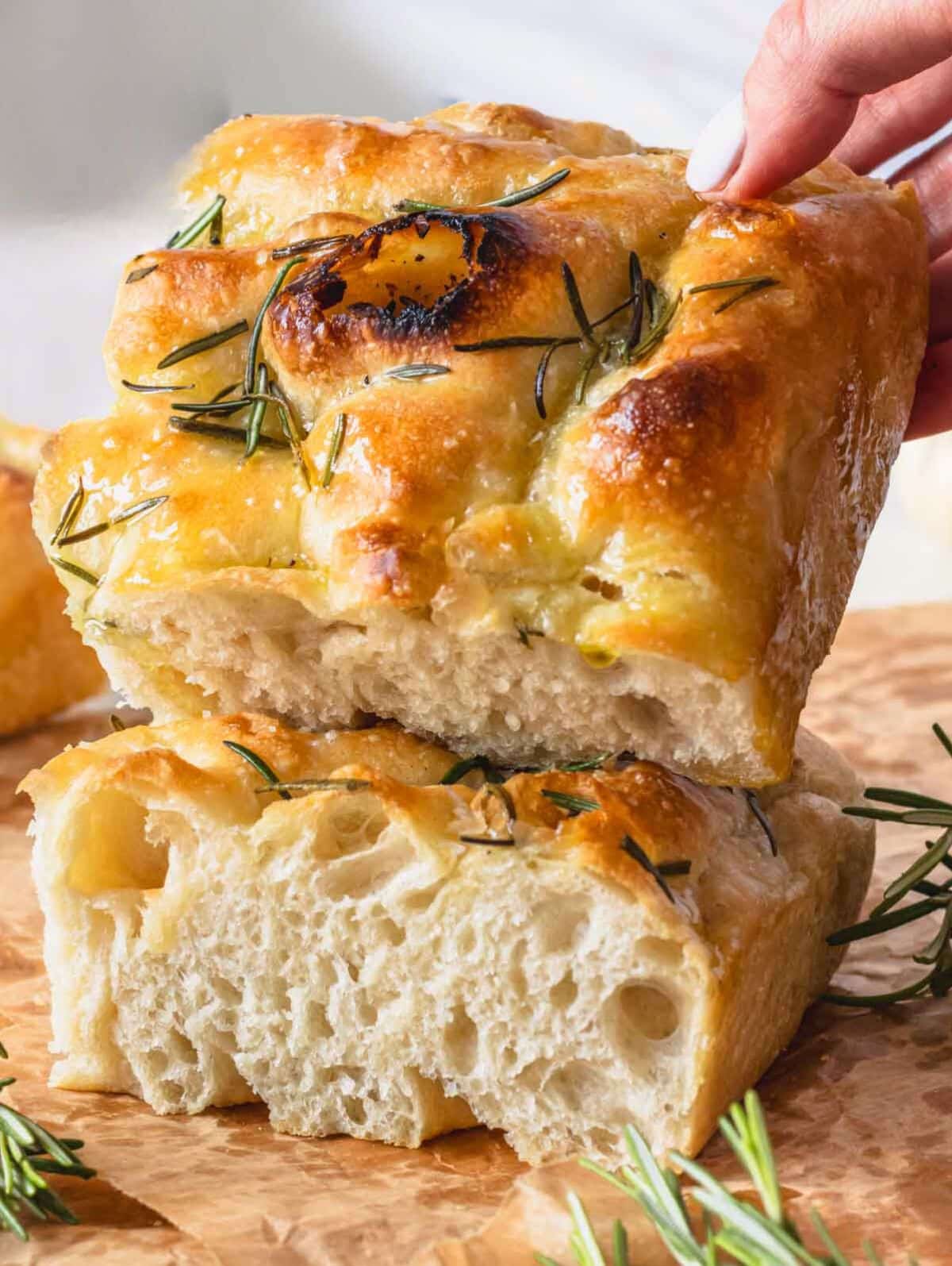
Table of Contents
Dietary Note: this recipe is suitable for a vegetarian and vegan diet. It’s low in cholesterol and saturated fat.
Don’t have time to read the full blog post? JUMP TO RECIPE HERE!
What is focaccia?
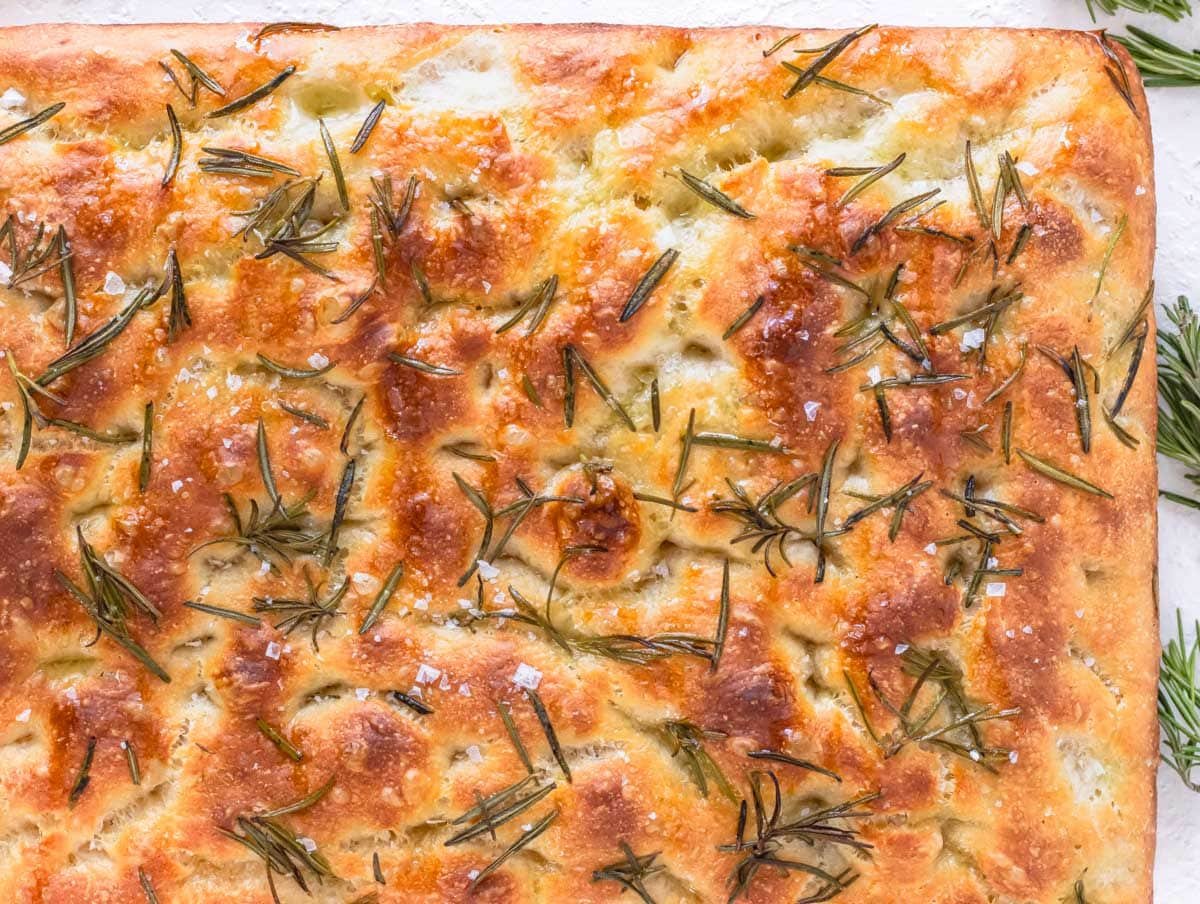
Focaccia, pronounced FOKACCHA, is a flat, oven-baked Italian bread that looks and tastes like something between pizza and bread.
In some regions of Italy, it is thin and crunchy, and it’s called “pizza bianca,” which translates as “white pizza.”
In others, it’s thicker, more similar to bread, cut in half, and filled with grilled vegetables, cheese, and cold cuts.

This article shows you how to make the best and easiest focaccia bread without kneading, without any fancy equipment, with just a bowl and a spoon, and in most baking pans.
Focaccia is usually topped with extra virgin olive oil, coarse salt, and fresh rosemary.
But there are many variations, and like with pizza, you can top it with anything you like.
Thick vs. Thin focaccia
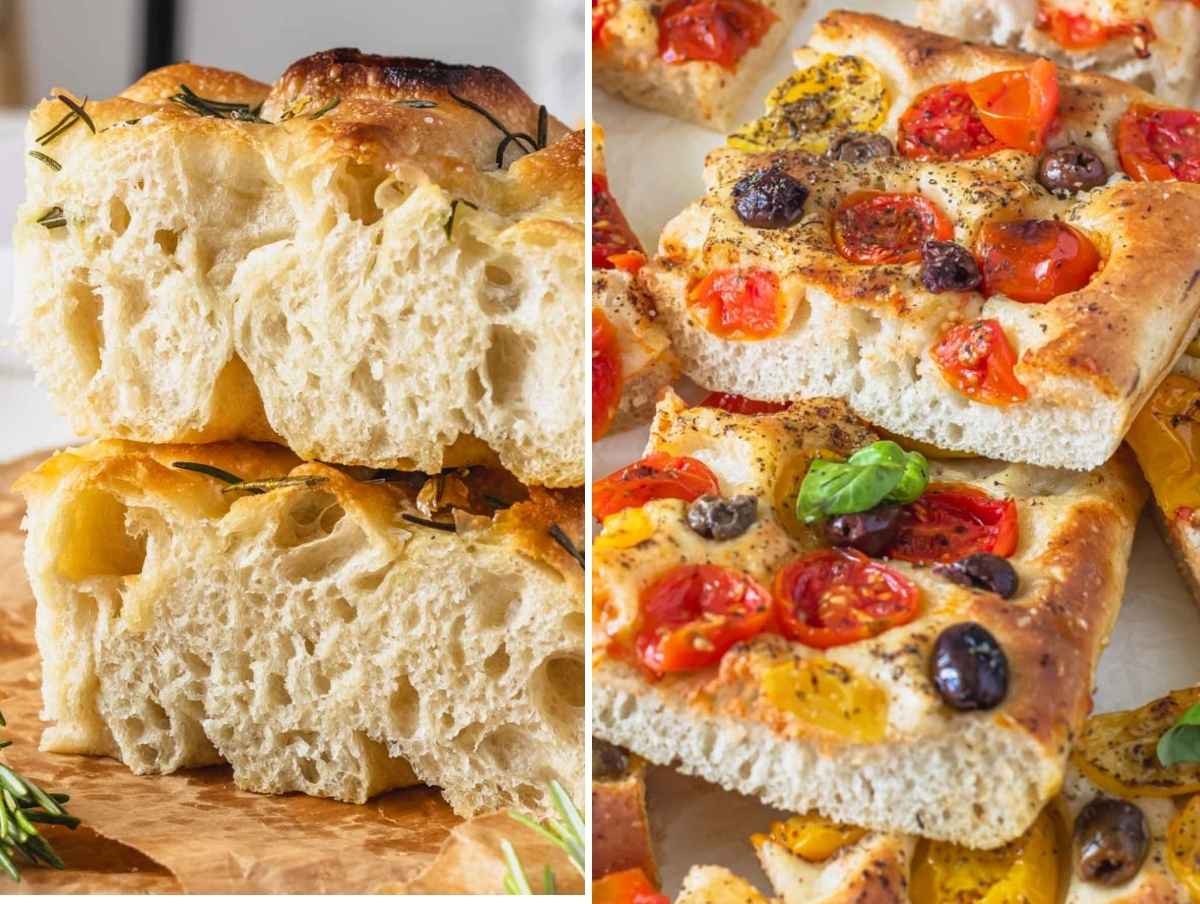
Depending on your taste, you can make a thick, bready focaccia or a thin, crispier one with the same dough.
Here, we use a standard-size rectangular 9×13-inch baking pan, which makes a thick focaccia.
Keep in mind that a smaller baking pan produces thicker and fluffier bread, and a larger pan makes thinner and crispier homemade focaccia.
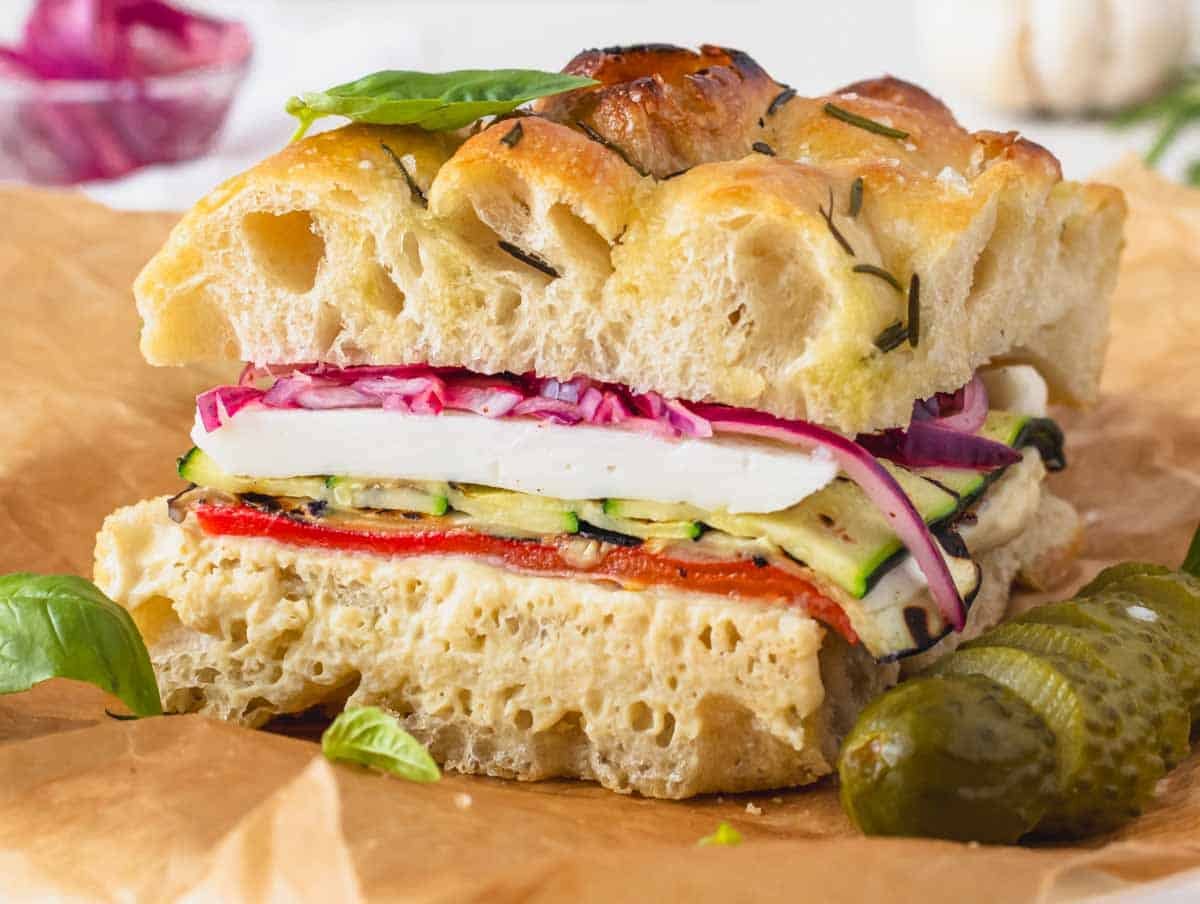
Thick focaccia is more like bread. You can cut it in half and stuff it with grilled vegetables to make focaccia sandwiches, dip it in soup, or eat it with salad.
Thin focaccia is more like pizza, made with several toppings.
It’s generally eaten on its own, often as a mid-morning snack, quick lunch, mid-afternoon snack, or for a convivial dinner with friends and family.
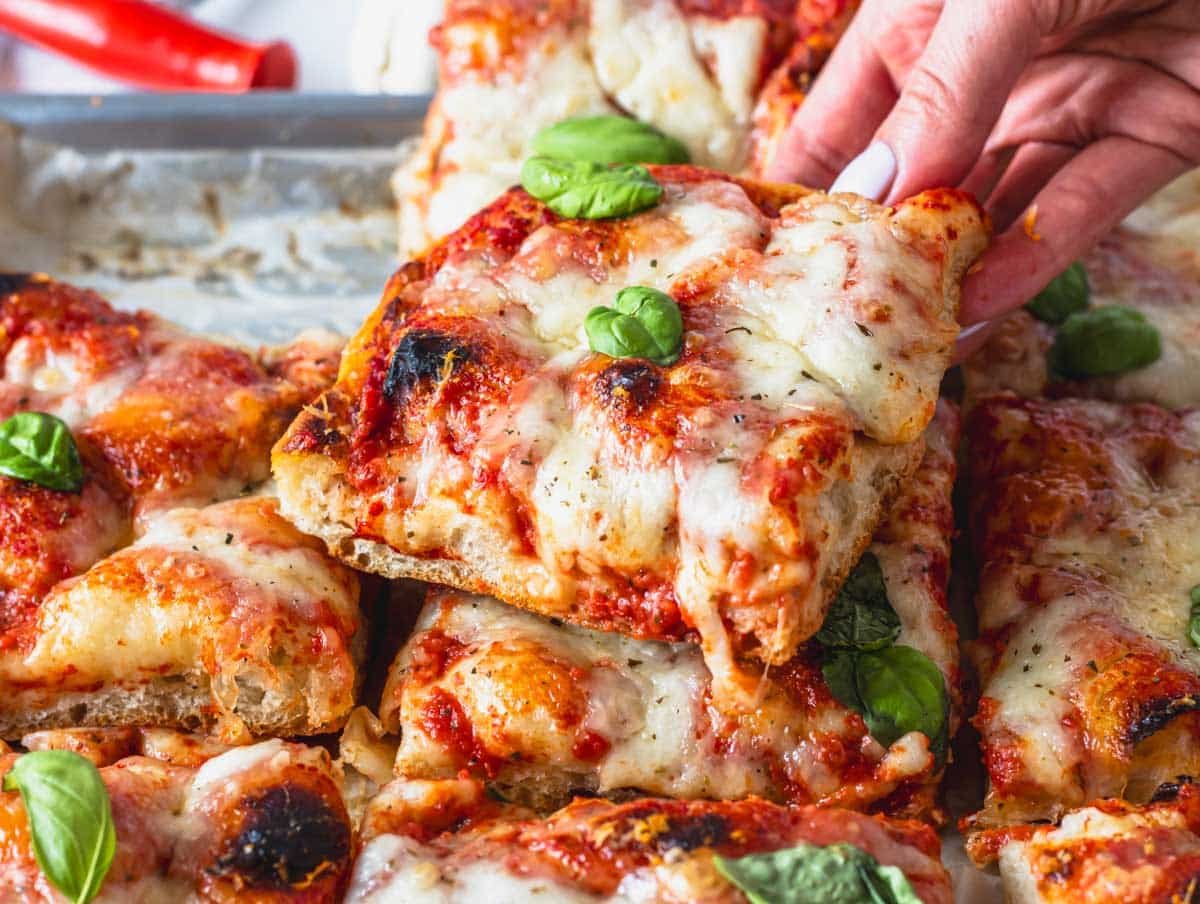
Ingredients and substitutions for focaccia
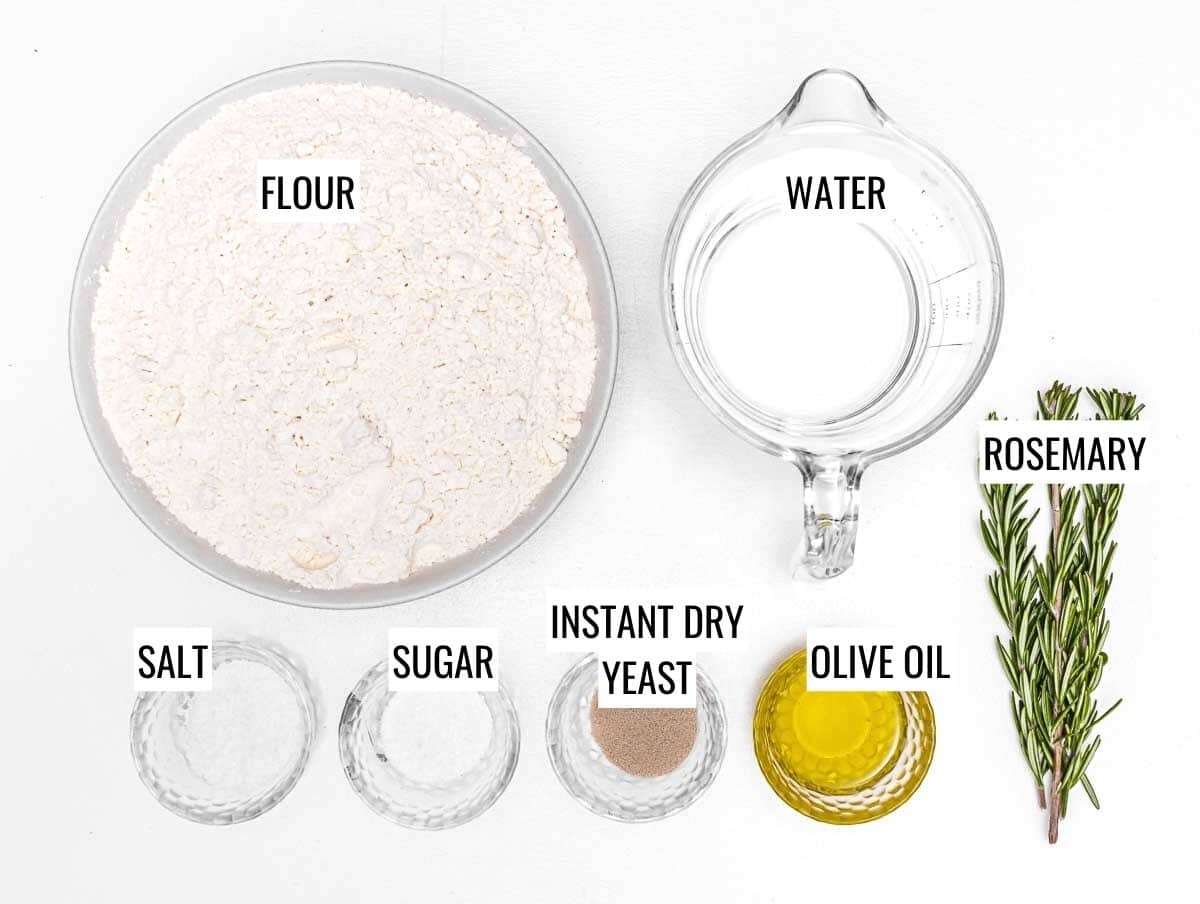
Quantities are in the recipe box at the bottom of the page.
Flour
You can use bread flour or all-purpose flour for this focaccia bread recipe.
Alternatively, you can combine half all-purpose and half whole wheat flour to make more wholesome bread.
In this case, add two extra tablespoons of water.
Water
Use lukewarm water to activate the yeast.
This is recommended if you are trying to make focaccia in 3 hours. Do not use hot water, as that will deactivate the yeast.
Yeast
We recommend instant dry yeast, SAF Instant Yeast and Caputo Dry Yeast are excellent.
Other brands will work, too, as long as they are stored well and used within their expiry date.
You can substitute active dry yeast or fresh yeast for instant dry yeast. If you use fresh yeast, you’ll need three times the amount of dry yeast.
In all cases, dissolve the yeast in lukewarm water first to activate it.
Salt and sugar
The salt is for flavor and to help develop the gluten structure that makes the focaccia tall and airy.
The sugar helps the yeast work faster (essential if you want to make this recipe in 3 hours, less so if you let it proof overnight).
It also helps the focaccia get a gorgeous golden color as it bakes.
Sugar is optional, and the recipe works well without it.
You can substitute maple syrup, diastatic malt, or honey for the sugar.
Extra virgin olive oil
Olive oil is optional in the dough, and if you want to make lighter focaccia bread with fewer calories, you can keep it out.
Our focaccia bread recipe works perfectly with and without oil in the dough.
We also use oil to prevent the focaccia from sticking to the baking tray. In this case, you can substitute parchment paper for oil but don’t expect the same flavor.
Toppings
Classic focaccia bread is topped with a mixture of extra virgin olive oil, water, and salt and sprinkled with fresh rosemary and coarse or flakey sea salt.
Check out the variation chapter to see ideas for other toppings.
Note: authentic Italian focaccia bread contains quite a bit of olive oil and salt. If you are on a low-sodium diet, you can reduce the amount of salt.
If you want to reduce calories, you can omit the oil in the dough, use parchment paper to line the baking tray instead of the oil, and reduce the oil on top.

Baking pans
You can make focaccia in most baking sheets and pans provided that they are well oiled, with at least two to three tablespoons of olive oil, or lined with parchment paper.
Here are some suggestions:
9×13-inch rectangular baking pan: we use this one in this blog post. It makes a medium to thick focaccia, which is excellent for rosemary focaccia bread, cutting it in half and filling it with veggies and cheese. It has a crunchy exterior and a soft and fluffy crumb.
13×18-inch half-sheet baking sheet: use this baking sheet to make thinner and crispier focaccia. This is our favorite when we want to make focaccia pizza with different toppings and have it for dinner.
8×8-inch square baking pan: use this to make a thick, bready focaccia. Excellent for cutting in half and filling with grilled veggies, cheese, and more or to use as a bread replacement.
9×9-inch square baking pan: slightly thinner than the 8×8-inch, but still relatively thick focaccia.
10 or 11-inch round cake pan: if you don’t have square pans, you can make round focaccia in a round cake pan or tart pan.
Tip: Focaccia tends to stick to the baking sheet. To prevent it from sticking, grease your pan with 2 to 3 tablespoons of olive oil, or, if you want to avoid fat, line the pan with parchment paper (less tasty and fewer calories).
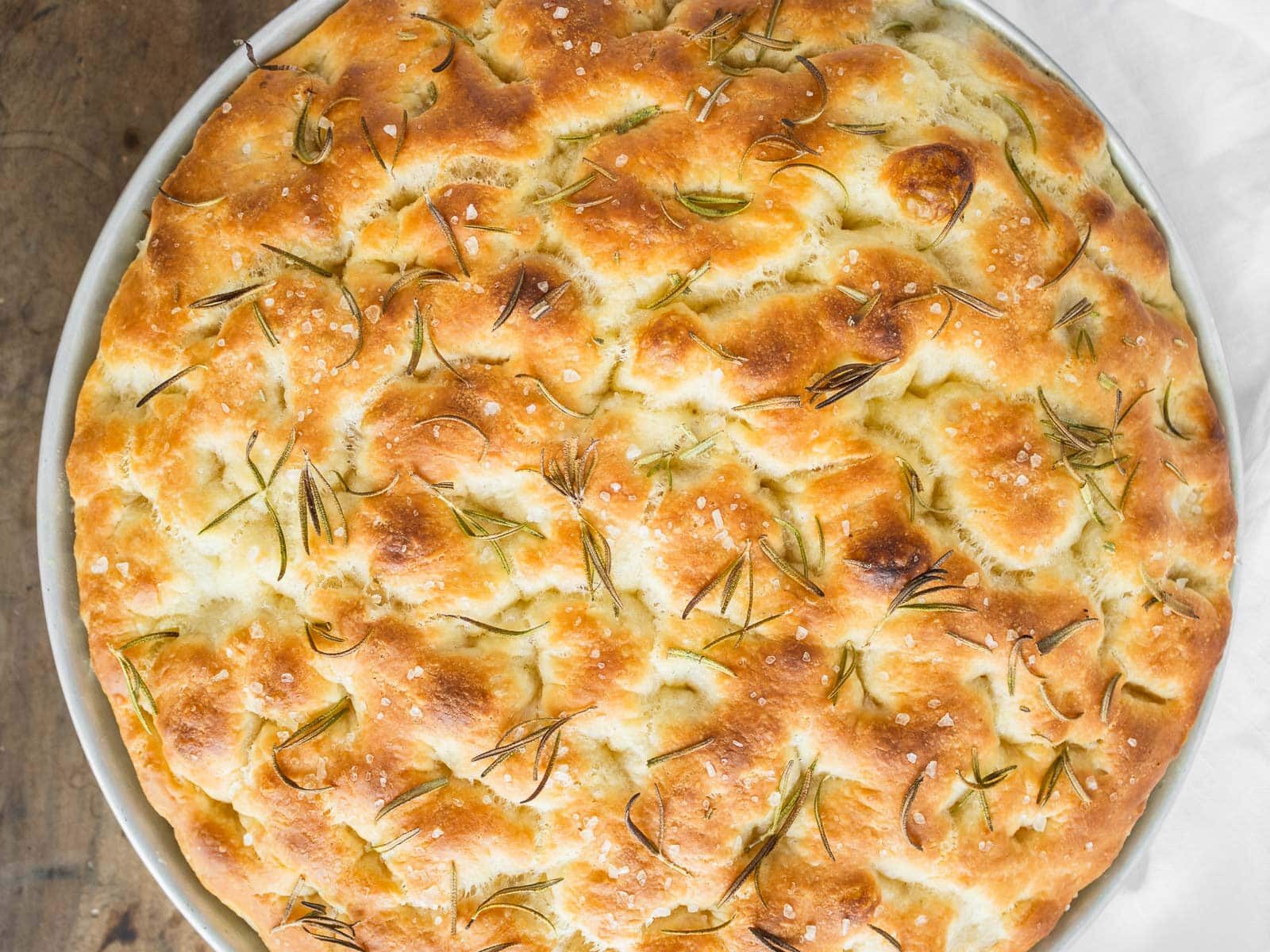
How to make focaccia
1. Measure your ingredients
Measure your ingredients in different bowls. We provide US cup measurements for your convenience.
However, we recommend using a digital scale as that’s much more precise, cleaner, and easier than measuring with cups.
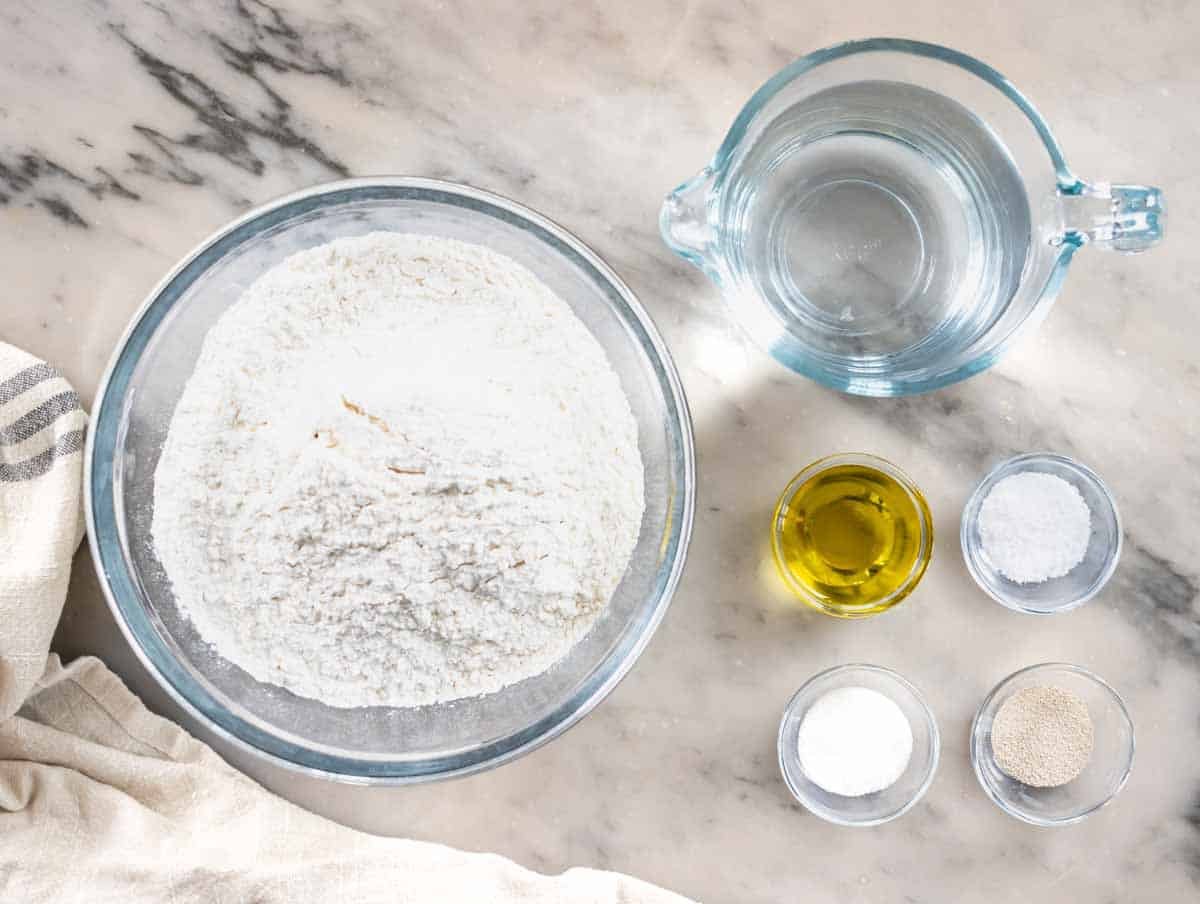
2. Activating the yeast
Add the lukewarm water, instant dry yeast, and sugar to a small container.
Whisk fast for 30 seconds to dissolve the yeast.
Tip: The dry yeast should dissolve fully, and small bubbles should form on the surface. If it doesn’t, it’s not good. Get new yeast and start over. The water temperature should be around 80°F or 27°C.
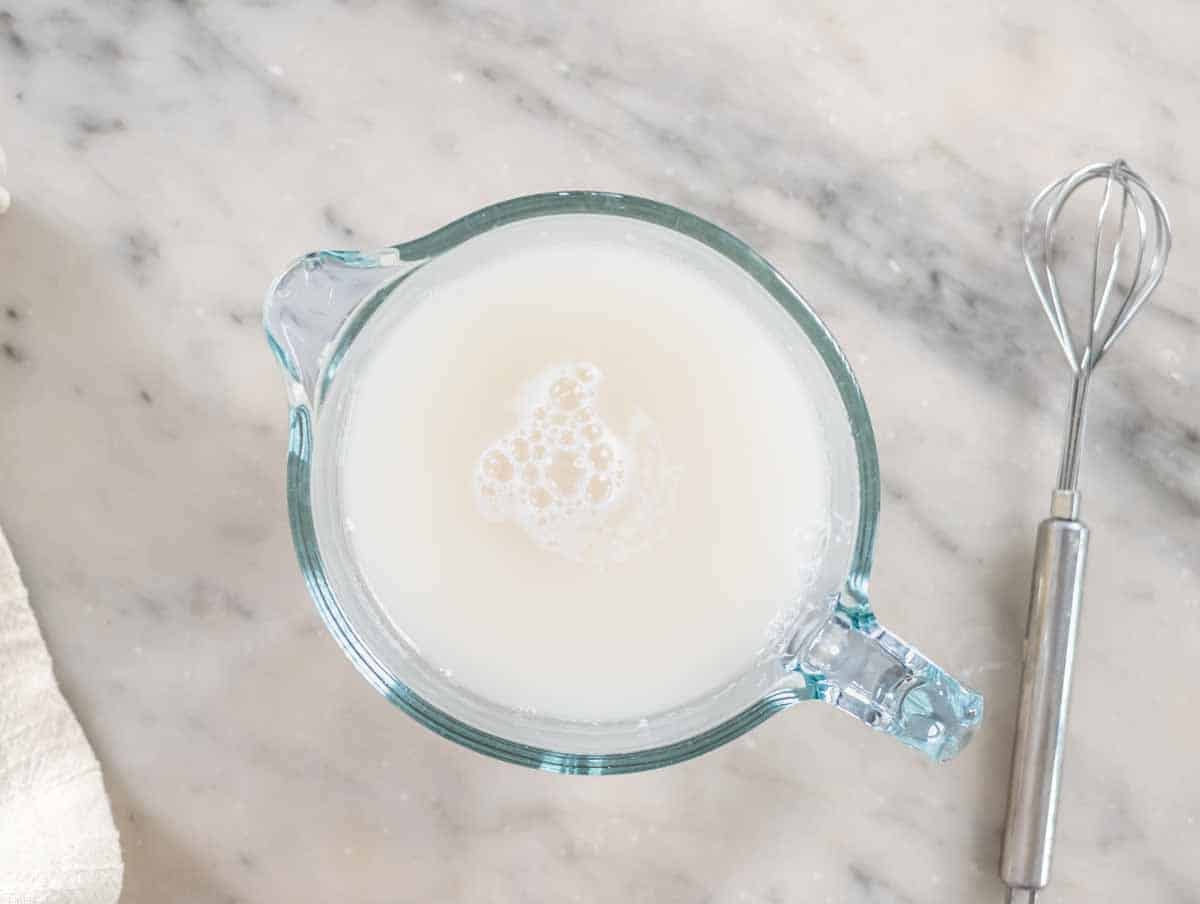
3. Making the dough
Add flour and salt to a large mixing bowl and stir to combine.
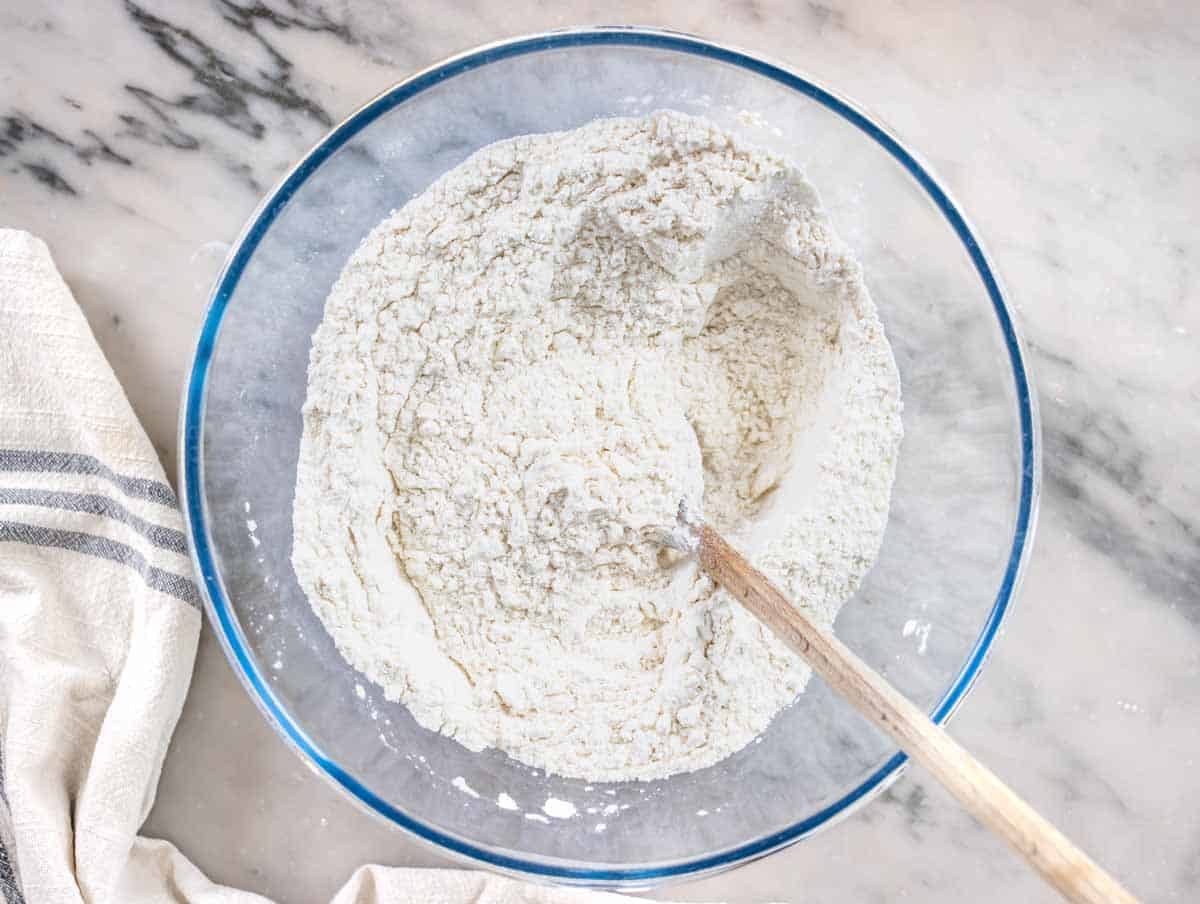
Add the yeast-water mixture and stir with a sturdy wooden spoon until you have a wet, sticky dough (about 1 minute).
Tip: You can follow the same instructions to make the dough with a stand mixer fitted with a dough hook attachment.
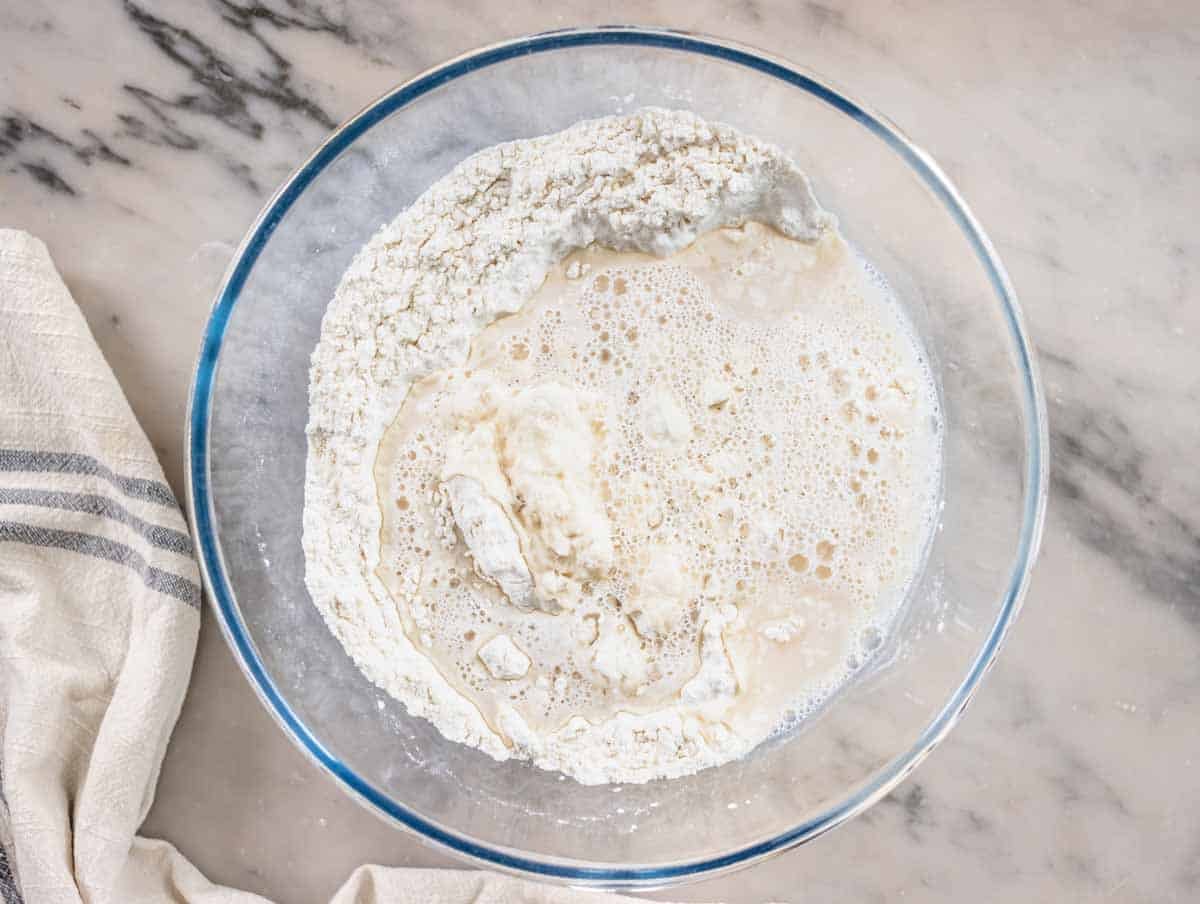
Add the extra virgin olive oil and keep stirring for one more minute or until it’s incorporated.
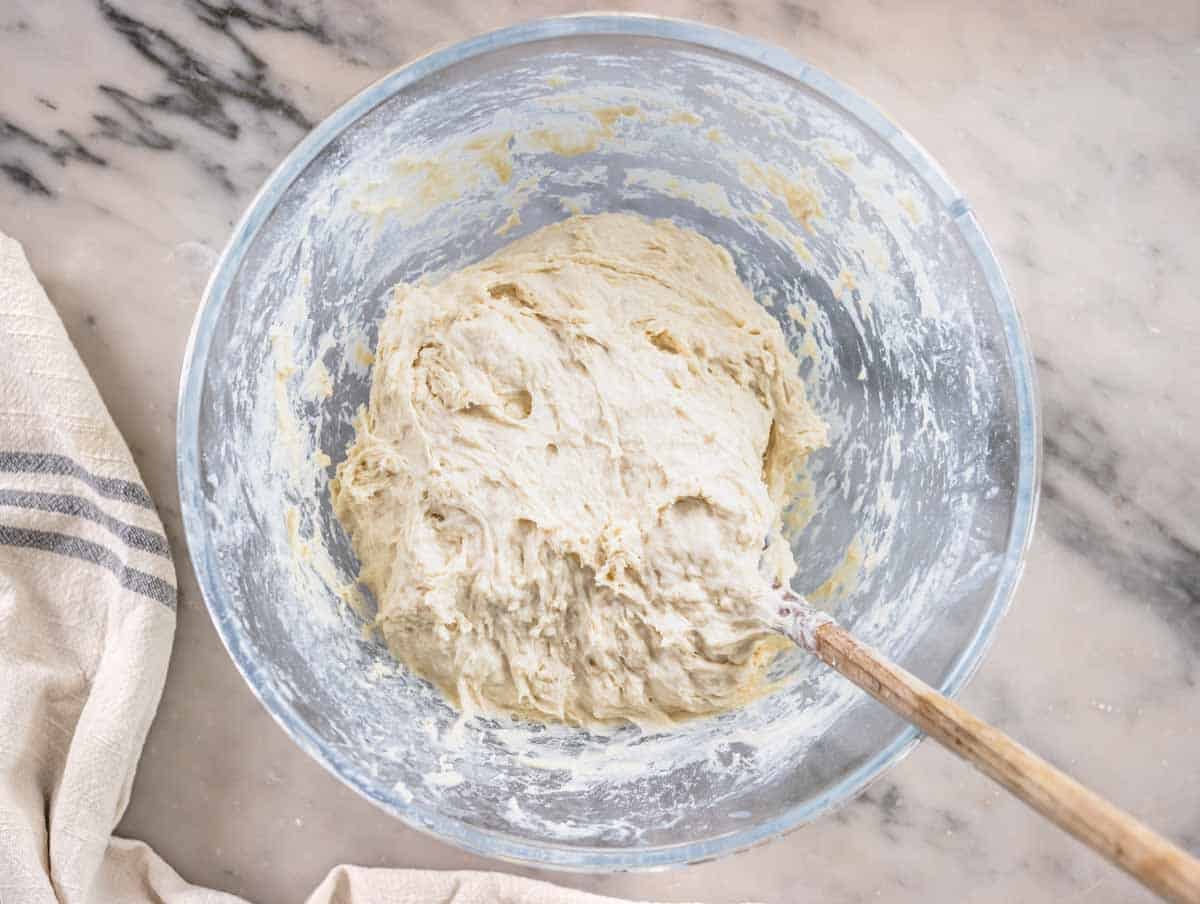
4. Proofing
There are two ways of proofing the dough: quick proofing, in about 2 hours in a slightly warm oven, and slow proofing, for about 8 to 24 hours, in the fridge.
Quick proofing allows you to make the focaccia in a few hours.
Slow proofing allows you to prepare the dough ahead of time, making focaccia more digestible, with a more complex flavor and lighter texture.
Quick proofing (1.5 to 2 hours)
Cover the bowl with a damp cloth or plastic wrap, leaving enough space between the dough and the cloth.
Put the bowl in a slightly warm oven for 1.5 to 2 hours or until double in volume.
The oven temperature should not be more than 80°F or 27°C.
Tip: to warm the oven, turn it on for 1 minute, then turn it off. If you live in a warm place, there’s no need to put the dough in the oven.
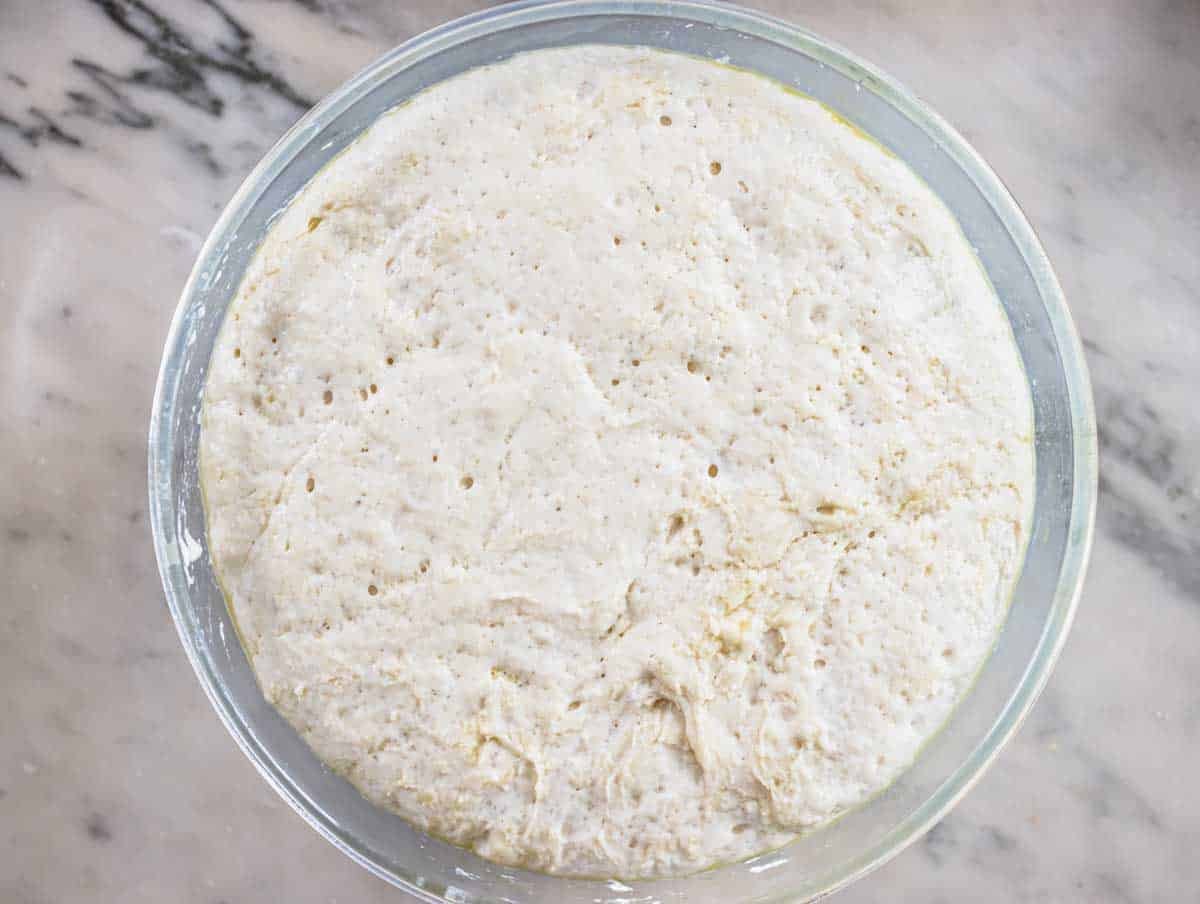
Slow proofing (8 to 24 hours)
Cover the bowl with plastic wrap and let the dough rise and mature slowly in the fridge for 8 to 24 hours.
After the dough rests in the fridge, you’ll need to take it out and leave it at room temperature for 2 to 3 hours before you can bake the focaccia.
5. Folding the dough
After proofing, fold the dough with a spoon over itself 20 times (it takes 30 seconds) from the outside to the inside while still in the bowl.
Tip: You don’t need to touch the focaccia with your hands; folding with the spoon is enough to give the dough structure.
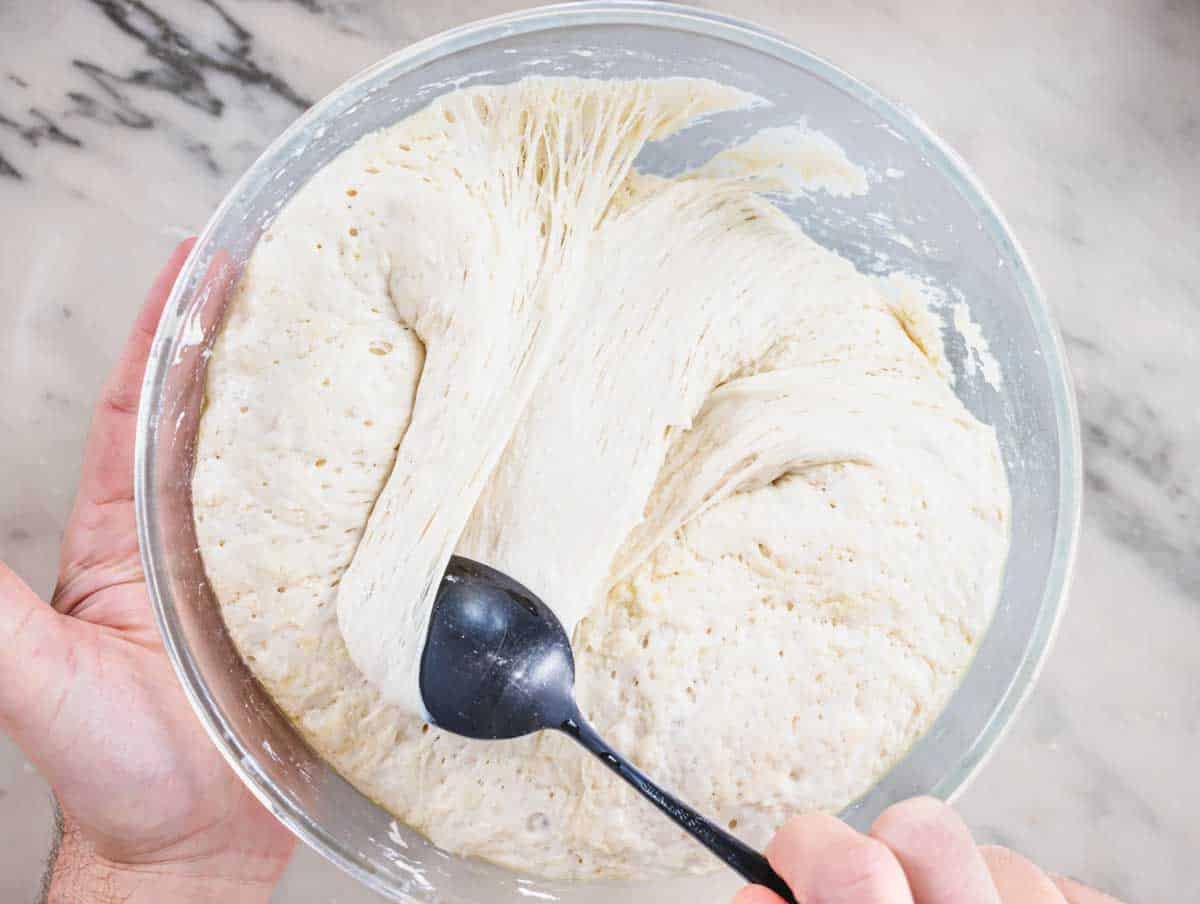
6. Final Proof
Grease your baking pan with 2 to 3 tablespoons of olive oil and drop the dough into the pan.
If the dough is from the fridge, brush it with a thin layer of olive oil and let it sit in the pan for 2 to 4 hours, depending on your room temperature. It should almost double in volume.
Tip: Focaccia tends to stick to the pan, so you need to use quite a bit of olive oil to prevent it from sticking. If you want to reduce the amount of fat, you can line your baking pan with parchment paper.
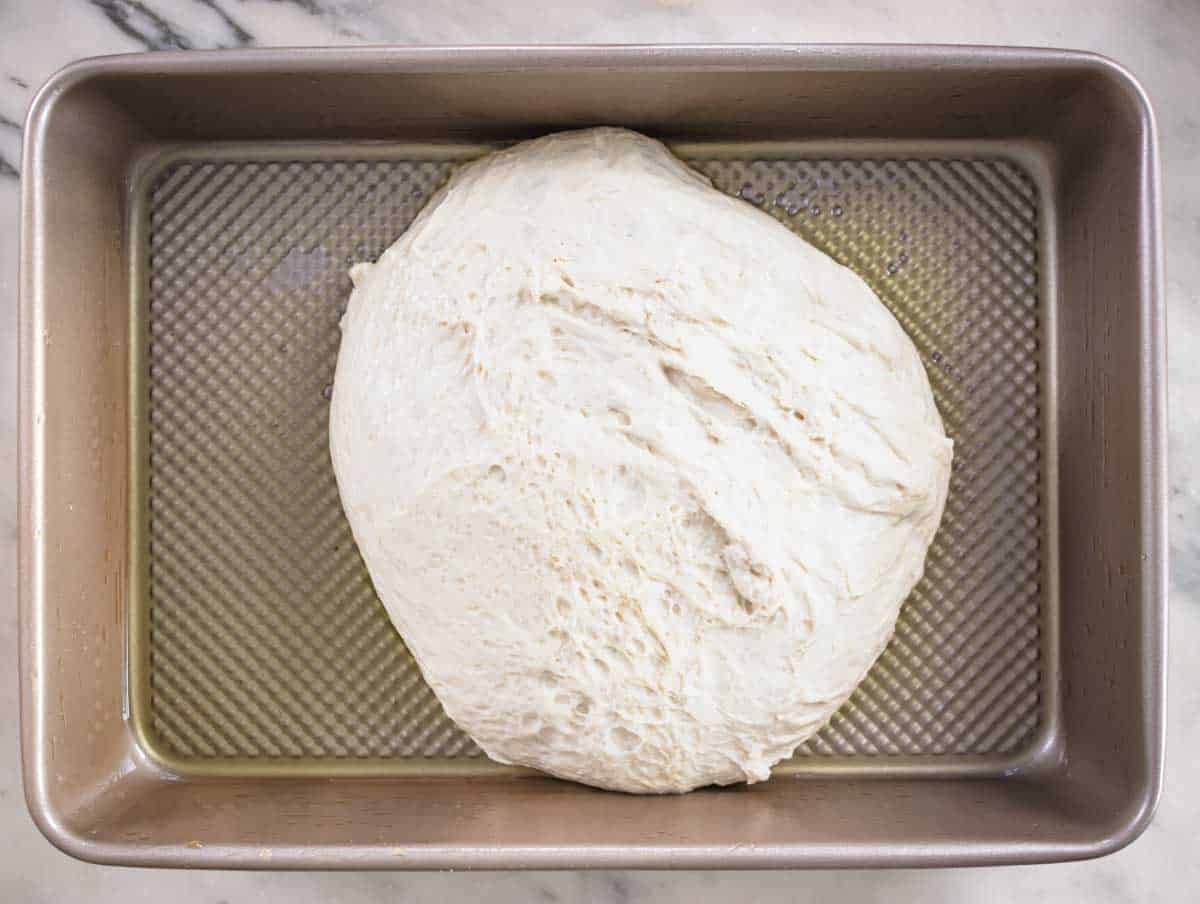
Spread the dough with the back of two spoons until most of the baking pan is covered.
Wet the spoons with water to prevent them from sticking. It’s okay if the focaccia gets a little wet on top.
Tip: The dough is elastic at this stage and will pull back, so don’t worry if it doesn’t cover the tray completely. If it’s too elastic, let it rest in the pan for 15 minutes, then try again.
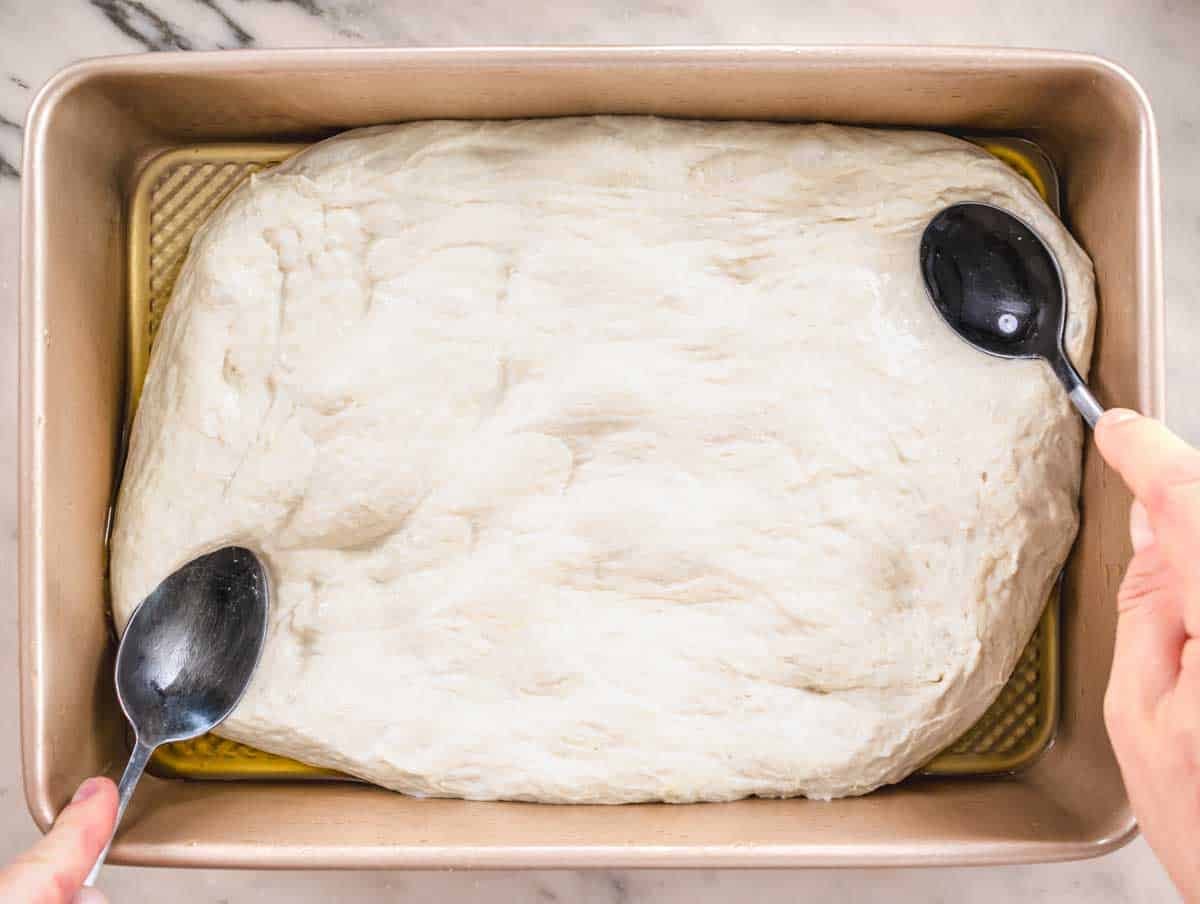
Proof a second time in a warm corner of your kitchen for 45 minutes.
In the meantime, preheat the oven to 450°F or 230°C, and make the topping.
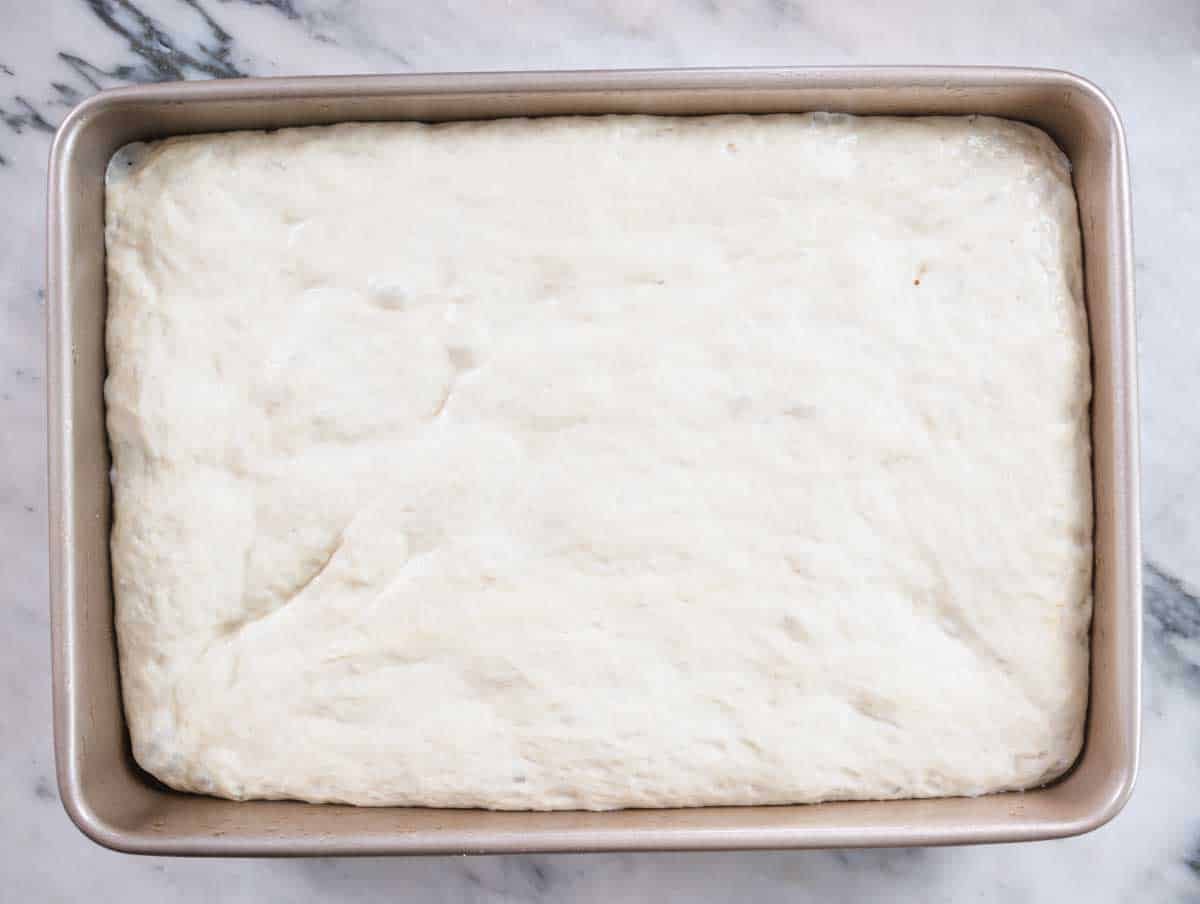
7. Making the topping
Add extra virgin olive oil, water, and salt to a small bowl. Stir well to dissolve the salt.
Dip your fingers in the oil-water mixture, then sink the tip of your fingers in the dough, making dimples across the focaccia.
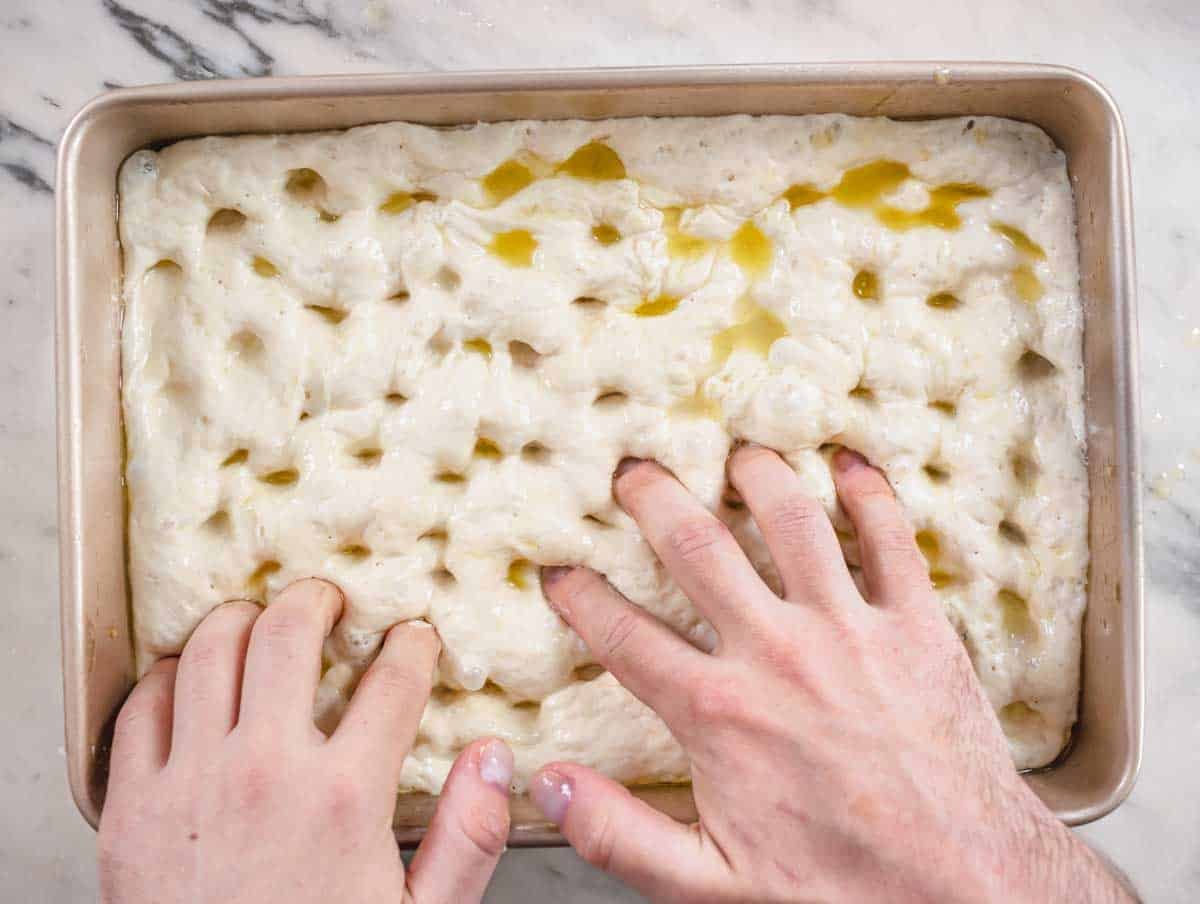
With a spoon, drizzle the remaining oil-water mixture all over the focaccia, allowing the liquid into all crevices.
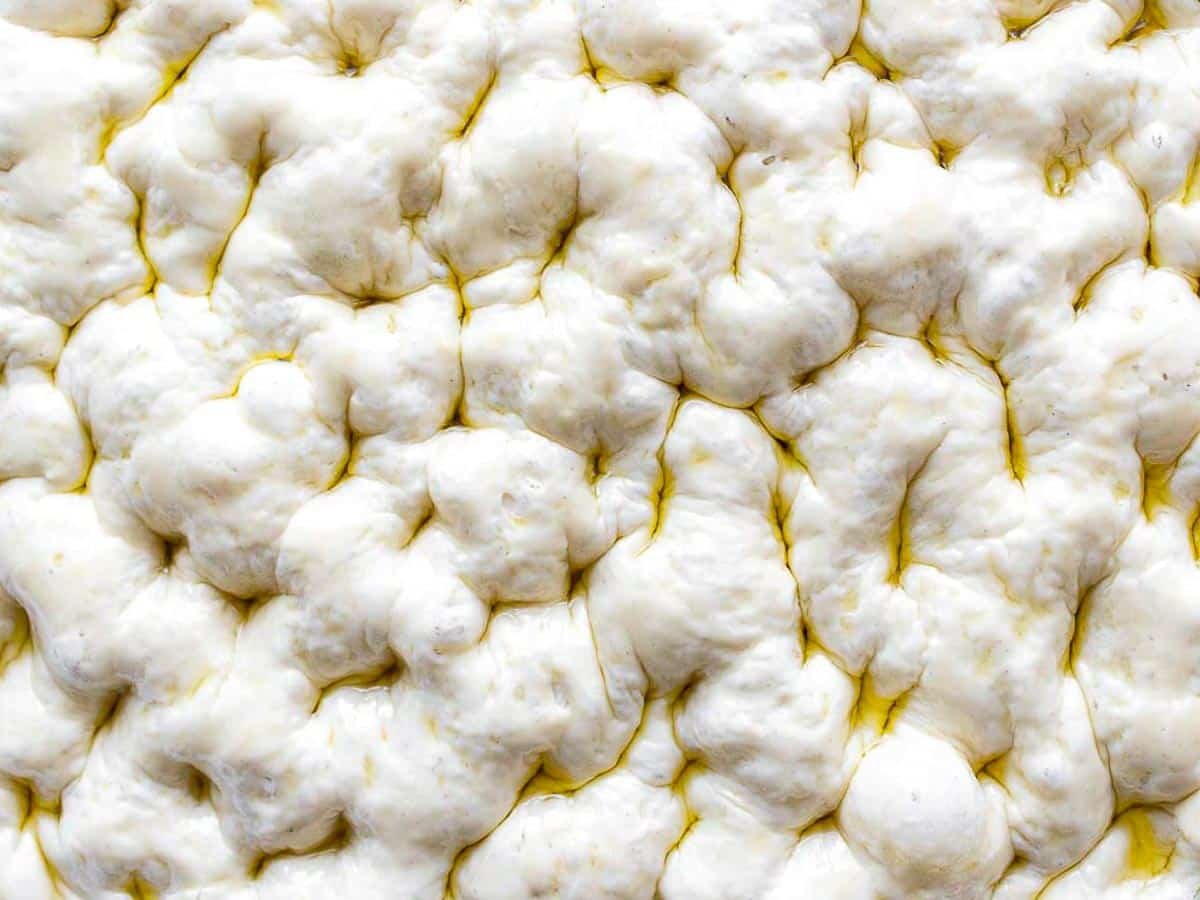
Top with fresh rosemary and sprinkle with flaky salt (like Malden salt), sea salt, or kosher salt.
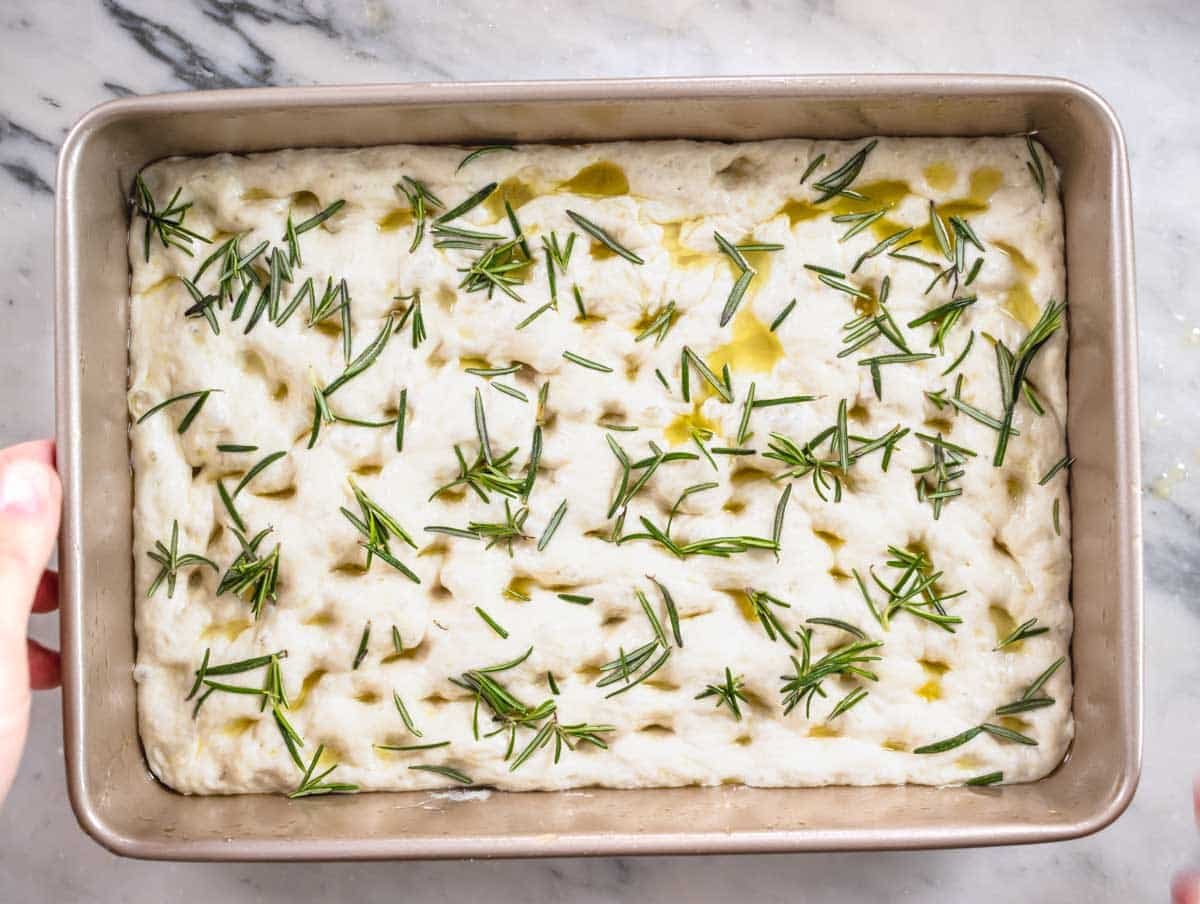
8. Baking the focaccia
When the oven reaches 450°F or 230°C, place the focaccia on the medium-low rack and bake it for 20 to 25 minutes.
Tip: Baking times vary. If your focaccia is thick, it’ll take closer to 25 minutes. If it’s thin, it’ll take closer to 20 minutes. It should be golden brown and crispy on top, well-cooked on the bottom, and still soft inside.

Let it cool down for at least 5 minutes before removing it from the pan, cutting it, and serving it.

Serving suggestions
Hummus focaccia sandwich

Cut the focaccia bread in half, spread hummus on the top and bottom layers, and stuff with roasted bell pepper, grilled zucchini, grilled eggplant, grilled halloumi or vegan halloumi, and quick pickled red onions.
Caprese focaccia sandwich

Cut the focaccia in half, spread a layer of basil pesto on the bottom.
Add arugula and season it with a pinch of salt and a few drops of olive oil.
Top with sliced mozzarella cheese or non-dairy mozzarella, sliced beefsteak tomatoes or vine tomatoes, and drizzle with more pesto sauce before topping with focaccia.
Focaccia with soups
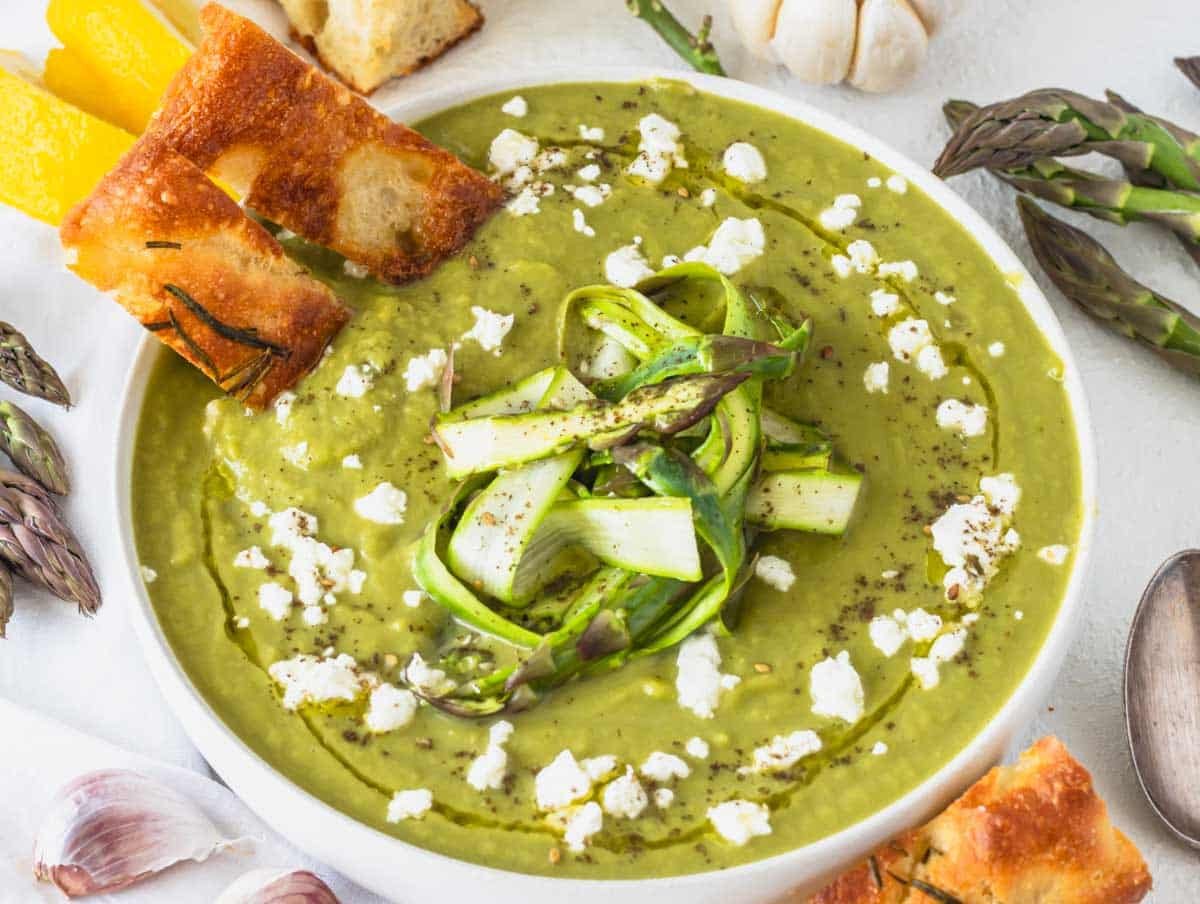
Cut the warm focaccia into smaller pieces and serve it next to soups like:
Focaccia with dips and spreads
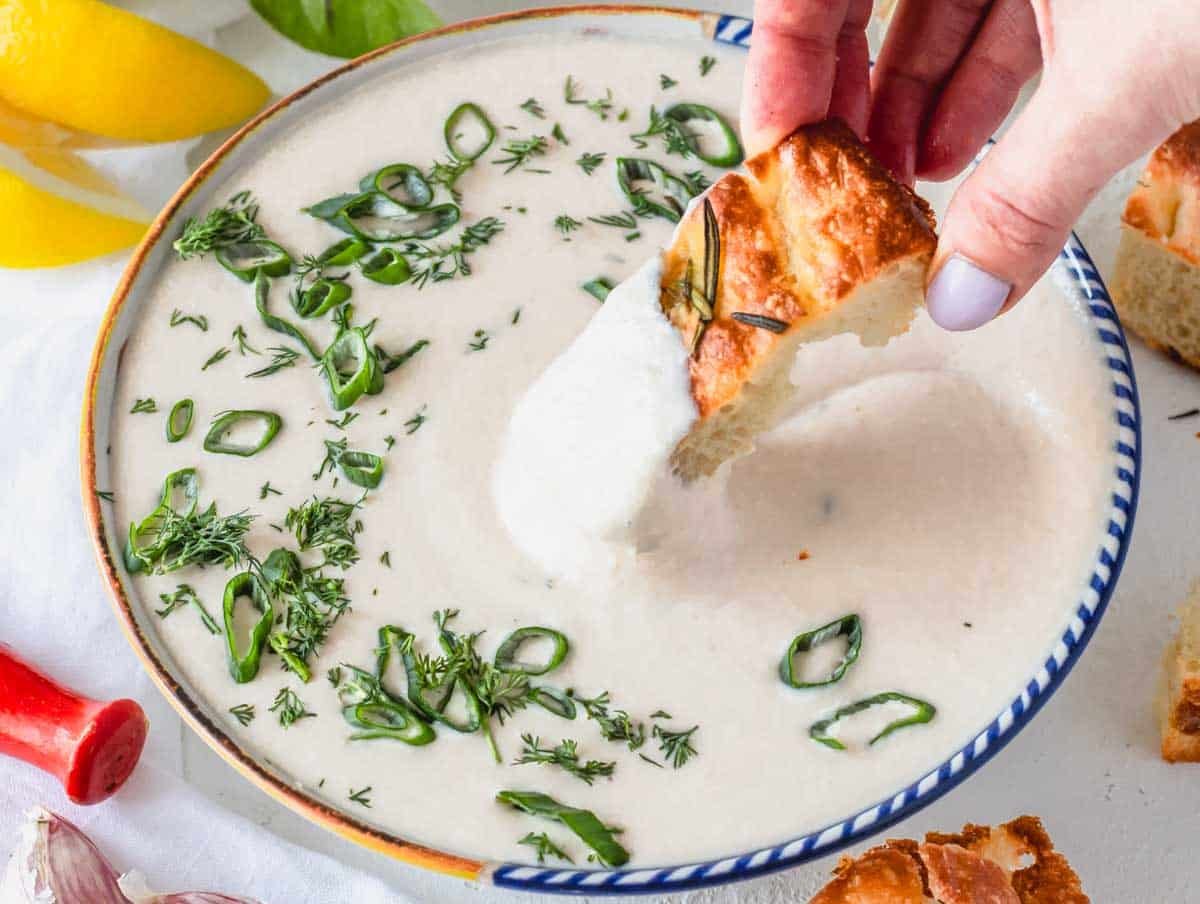
Serve focaccia with dips, spreads, and small dishes, for example, on a meze platter instead of pita bread.
We love it with:
- Roasted red pepper hummus
- White bean dip
- Avocado spread
- Tomato confit
- Caramelized onions
- Guacamole
- Lentil hummus
- Muhammara
- Kalamata olives and feta cheese
Focaccia instead of bread
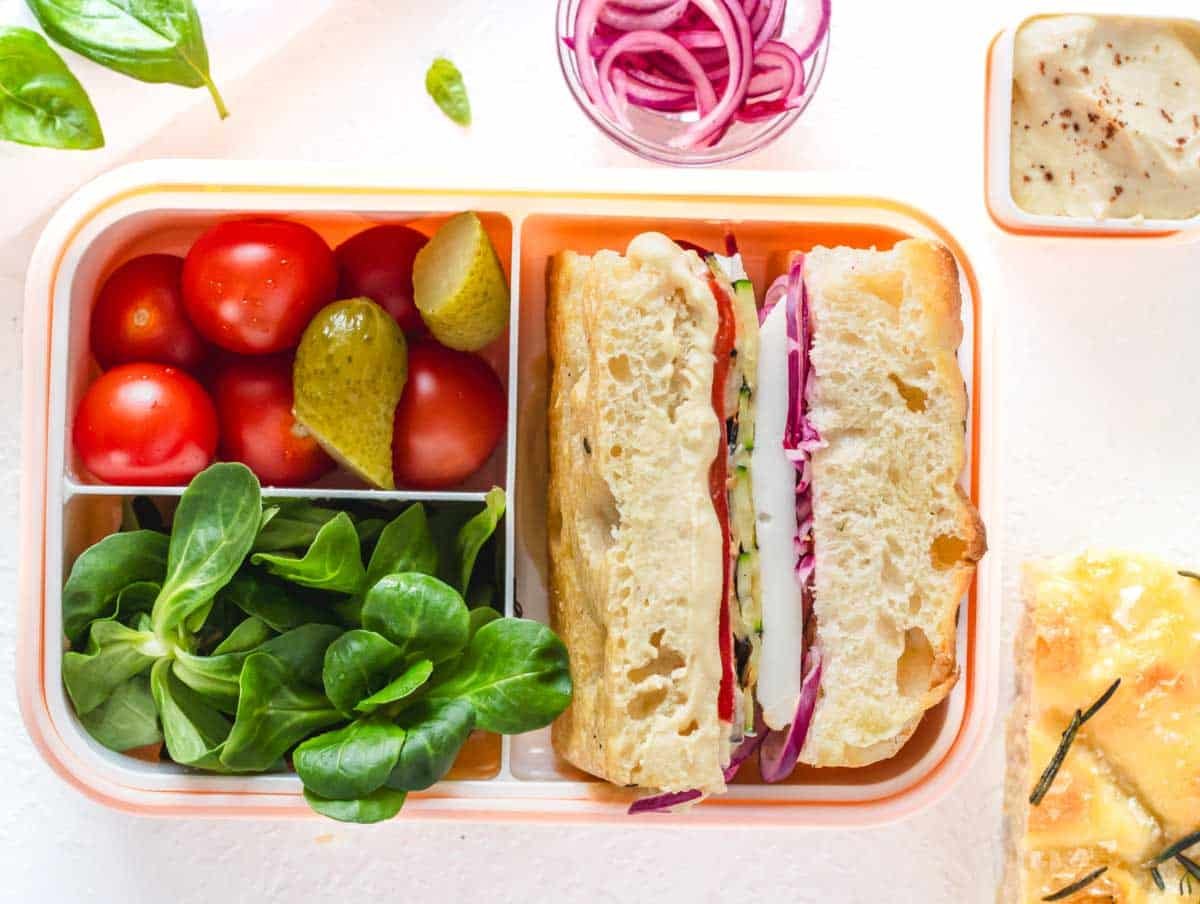
Make a sandwich and have it for a packed lunch. Or eat this focaccia instead of bread with main courses and salads. You’ll love it with:
Variations
Focaccia pizza

Focaccia pizza is something in between focaccia bread and pizza. It’s thinner than focaccia and thicker than pizza.
It’s easy to make and can top it with your favorite toppings.
Here’s our focaccia pizza recipe.
Cherry tomato foccaccia
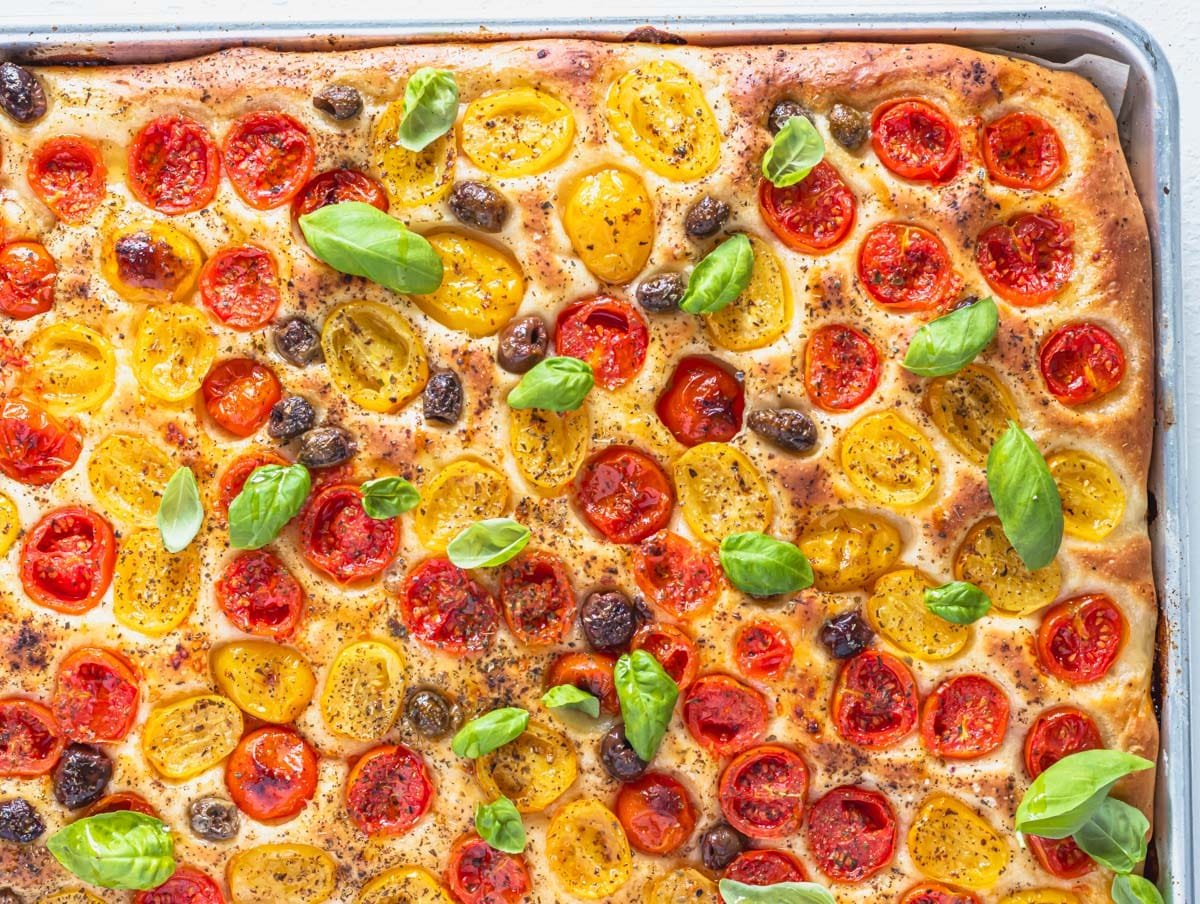
It is similar to focaccia pizza, topped with cherry tomatoes, olives, and oregano.
Here’s our cherry tomato focaccia recipe.
Rustic tomato focaccia
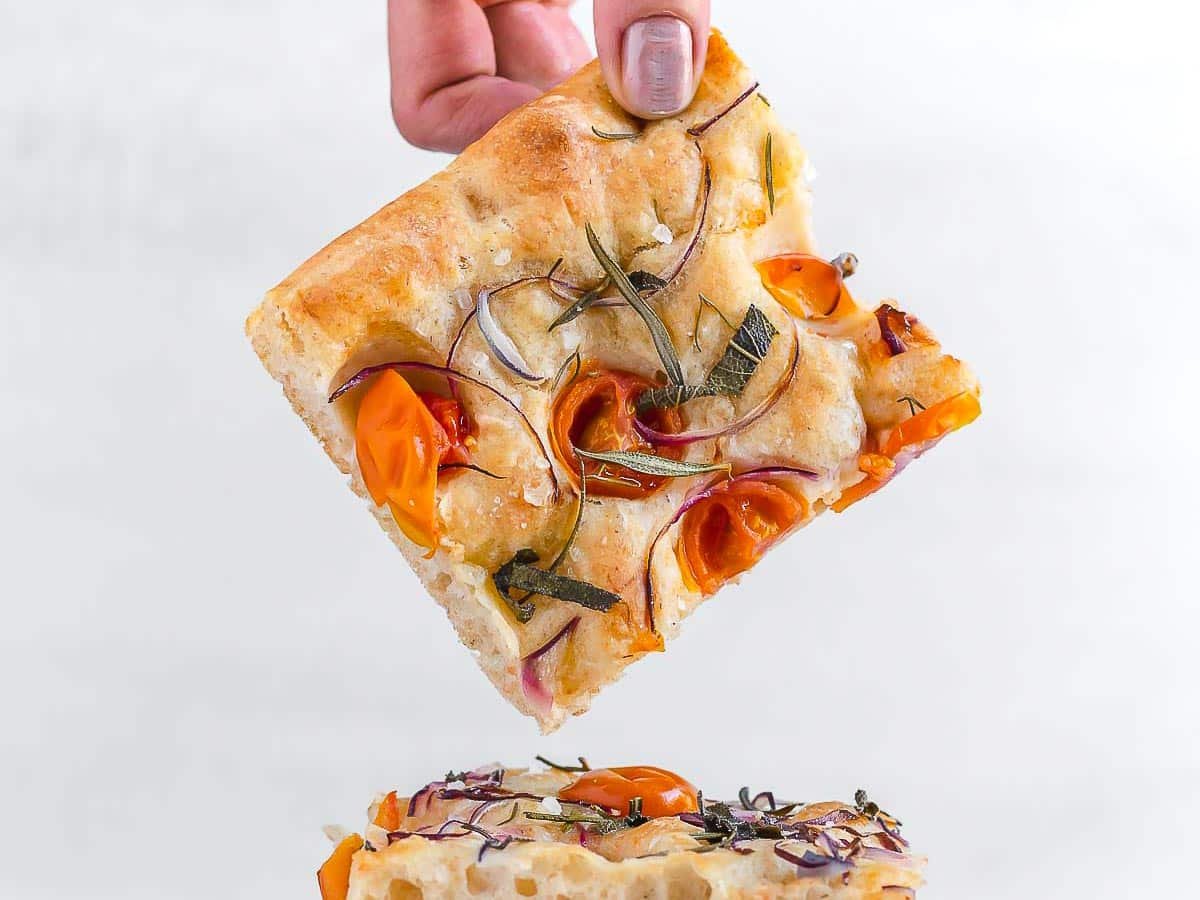
To make our rustic focaccia, top the dough with cherry tomatoes cut in half (push them well into the dough), chopped sage, rosemary, finely chopped onion, a generous sprinkling of salt, and a few grains of coarse salt or flaky salt (you can add olives too if you like) and garlic if you want.
Zucchini focaccia
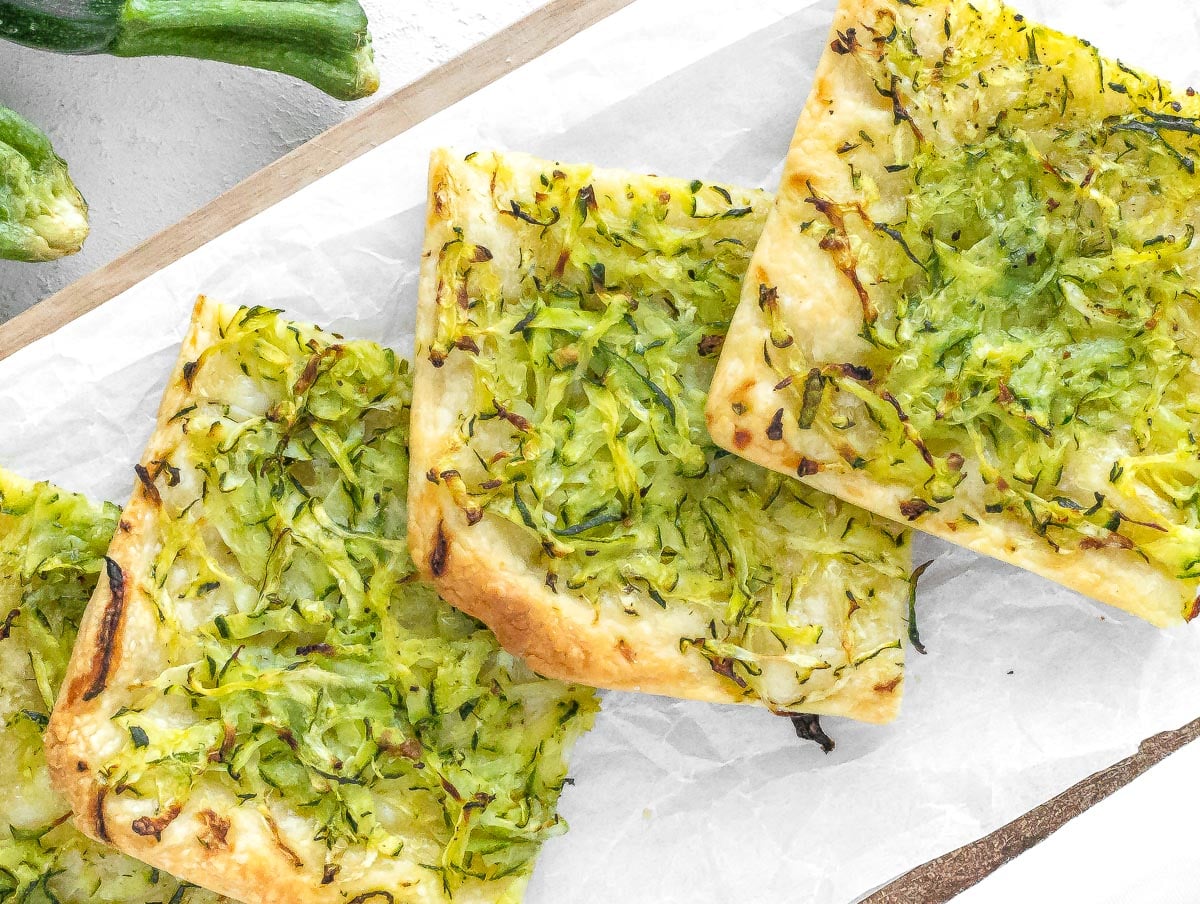
Focaccia with grated zucchini on top is a colorful, tasty, and crunchy focaccia recipe that is very easy to make.
Check out our zucchini focaccia recipe.
Whole-wheat focaccia
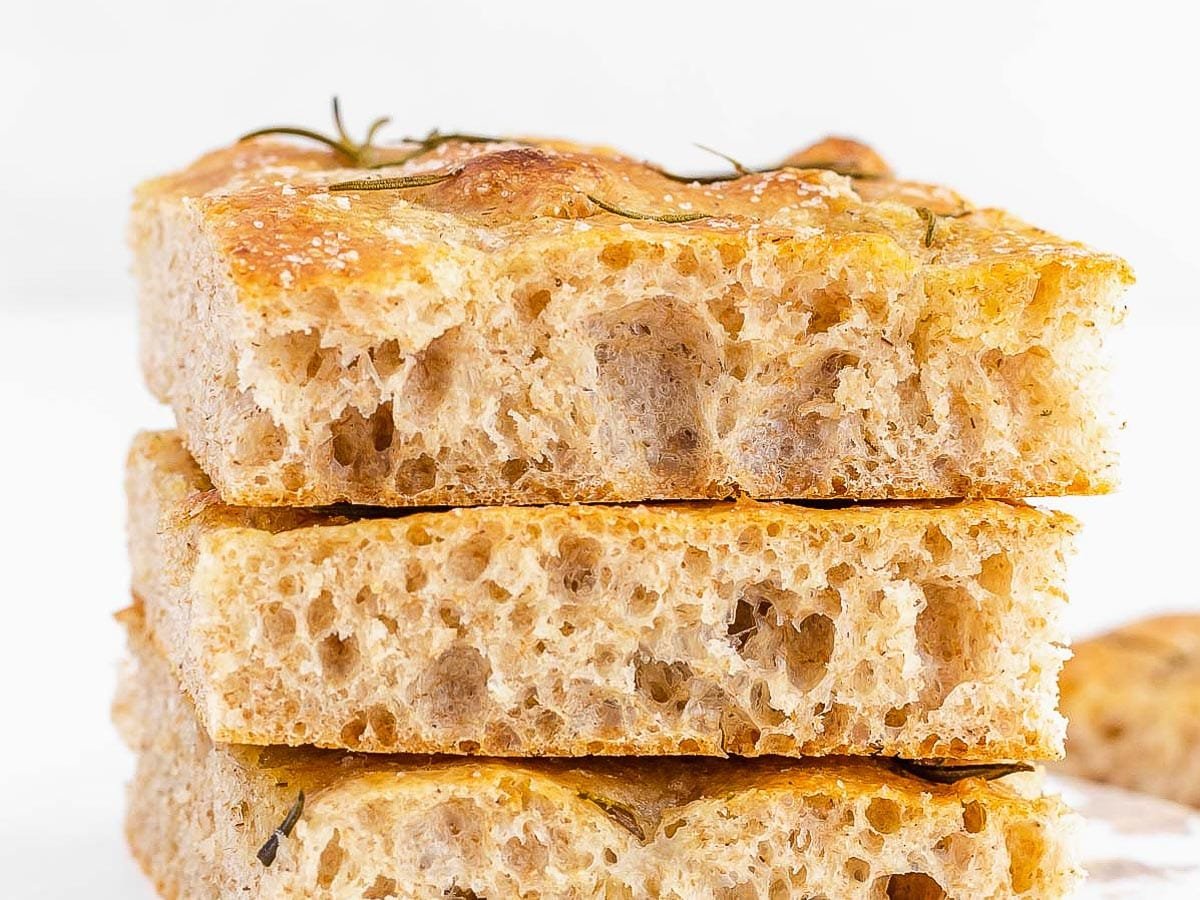
Whole-wheat focaccia is a tasty and wholesome alternative to focaccia made with all-purpose flour.
To make it, substitute half whole-wheat flour for all-purpose flour and add two extra tablespoons of water to the dough.
Storage & Make ahead
Make ahead: Focaccia is best eaten within a few minutes, straight out of the baking tray, and still warm and crunchy. However, you can make the dough ahead of time and let it in the fridge for several hours. We explain this in detail in our “slow proofing” chapter above.
Room temperature: if you have leftovers, you can store them in a plastic food bag or an airtight container at room temperature for a couple of days, not in the fridge.
Freezer: let the focaccia cool down completely, cut it into squares, put it in a freezer-friendly bag, and freeze for up to 3 months.
Thaw: defrost frozen focaccia in the microwave with a thawing function or leave it at room temperature for 2 hours before reheating it.
Reheat: reheat focaccia in a preheated oven at 360°F or 180°C for 10 minutes or in an air-fryer for 5 minutes.
Tips
Yeast and proofing time
Proofing the dough for many hours, up to 36, in the refrigerator makes the focaccia lighter, tastier, and more digestible.
As you become more proficient in making focaccia, you can further experiment with reducing the amount of yeast. Focaccia (and bread) with less yeast and more proofing time is a better, higher-quality, more digestible product.
High hydration
Hydration, in this case, means the amount of water compared to the amount of flour. This focaccia has a hydration of 75%, which is relatively high.
High hydration allows us to get soft focaccia, which is full of air bubbles and crispy on the outside.
This is done without kneading the dough, using sourdough, or proofing and maturing the dough for very long.
Fold the dough on itself several times.
When carried out with a spoon or a kitchen spatula, this technique is sufficient to create a strong enough gluten network.
The gluten network can retain the air released by the yeast during the second rising and baking.
This is essential in obtaining airy, bubbly, and soft focaccia.
I made this focaccia many times, and I can confidently tell you that folding the dough on itself 40 times is sufficient to develop a good texture. It only takes a minute!
Poke with your fingertips.
To be good, Focaccia must have holes made with the fingertip where the olive oil collects and where the dough is slightly less cooked than the top part of the focaccia.
The slightly undercooked dough combined with the crunchy part makes the focaccia genuinely irresistible when you bite into it.
Moreover, making holes with the tip of fingers allows the air released by yeasts to remain in the dough.
A mistake would be to push the focaccia with the whole palm.
If you do that, you will push the air out of the dough, making a focaccia that is too flat and compact.
Add oil and water on top.
In many Italian regions, people like to season focaccia with a brine of water, extra virgin olive oil, and salt before baking it.
This emulsion goes into the crevices you made with your fingers and causes the focaccia to be more flavourful and slightly moist in these holes.

Questions
There are 4 ways you can make focaccia healthier: reduce salt, reduce oil, use whole wheat flour, and add veggies on top.
Olive oil and salt are essential ingredients in focaccia. However, we understand that you might want or need to reduce the amount of oil and salt due to dietary choices or health requirements.
You can make this recipe without any oil in the dough. We tested the dough also without salt. It’s not as tasty, but it will still be excellent if you top it with plenty of veggies and salt.
To reduce oil further, use parchment paper to line the baking pan. Don’t add pure oil on top of the focaccia; dilute it with water. Also, remember that extra virgin olive oil is healthier than regular olive oil.
You can substitute all-purpose flour with whole wheat flour up to 75% of whole wheat without changing the recipe. That adds fiber to the focaccia and makes it healthier and more fulfilling.
Finally, top or serve the focaccia with your favorite veggies: cherry tomatoes, grilled zucchini and aubergines, artichokes, olives, and more.
Italian focaccia traditions
Focaccia (sometimes interchangeably called pizza bianca and pizza al taglio) is one of the most popular Italian street foods.
In Italy, its birthplace, it is most often eaten on its own as a late breakfast, mid-morning snack, mid-afternoon snack, or even as a low-key dinner with friends.
There are so many types and variations of focaccia there that you never get tired of it. Each region has its slight variations, all delicious.
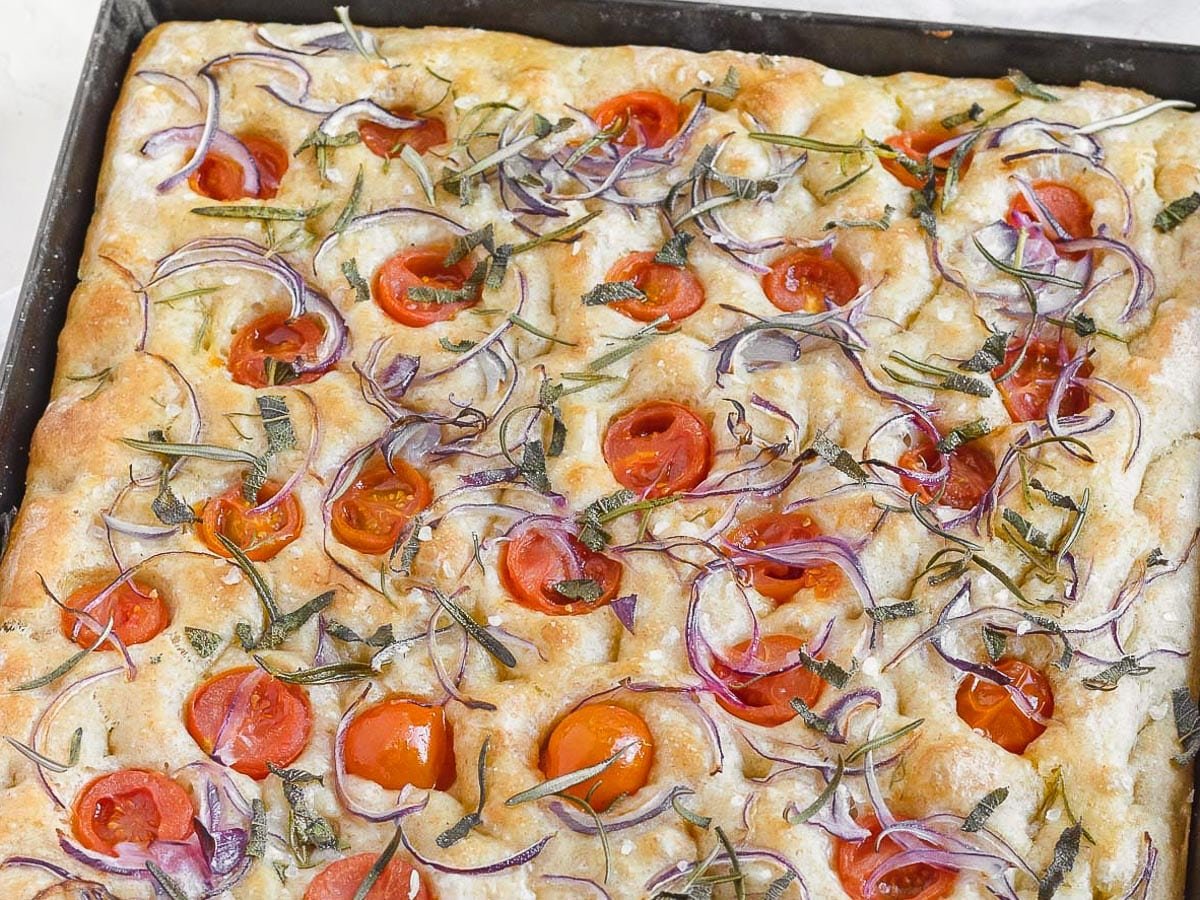
Focaccia Genovese, Focaccia di Recco, Focaccia Barese, Pizza Bianca Romana, Focaccia alla Messinese, Schiacciata Toscana, Strazzata Lucana, Vastedda, Sfincione Palermitano, Sceblasti, Tiròt di Felonica, Chisola coi grasei, Pitta Calabrese, and many more.
Fun fact: In Italy, focaccia places are as frequent as McDonald’s and Starbucks combined in the US.
They are everywhere! And they are all (or almost all) family-owned, meaning that everyone makes slightly different focaccia according to their family history and traditions, which is fantastic.
More easy bread recipes
- Flatbread pizza
- Focaccia pizza
- Pita bread
- Naan
- Piadina (Italian flatbread)
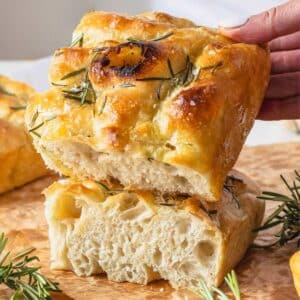
Focaccia
Equipment
- 9×13-Inch (23×33 cm) rectangular baking pan: See the notes below the recipe for more pan options.
Ingredients
FOR THE DOUGH
- 1¾ cups lukewarm water
- 2 teaspoons instant dry yeast substitute active dry yeast
- 2 teaspoons sugar
- 4 cups all-purpose flour or bread flour
- 3 teaspoons salt
- 2 tablespoons extra virgin olive oil optional, + 2 tablespoons to grease the baking pan (substitute parchment paper)
TOPPING
- 2 tablespoons extra virgin olive oil
- 3 tablespoons water
- ½ teaspoon salt
- 1 teaspoon flaky salt
- 5 sprigs rosemary
Instructions
MEASURING THE INGREDIENTS
- Start by measuring your ingredients in different bowls.
ACTIVATING THE YEAST
- To a small container, add 1¾ cups lukewarm water, 2 teaspoons instant dry yeast, and 2 teaspoons sugar.Whisk fast for 30 seconds to dissolve the yeast. If it doesn't, start over with new yeast.
MAKING THE DOUGH
- To a large mixing bowl, add 4 cups all-purpose flour and 3 teaspoons salt. Stir to combine.Add the yeast-water mixture, and stir with a sturdy wooden spoon until you have a wet, sticky dough (about 1 minute).Add 2 tablespoons extra virgin olive oil and keep stirring for one more minute or until it’s incorporated.
PROOFING (pick one method)
- QUICK PROOFING: cover bowl with damp cloth, leaving enough space between the dough and the cloth.Proof in a slightly warm oven (max 80°F or 27°C) for 1½ to 2 hours, or until double in volume.To warm the oven, turn it on for 1 minute, then turn it off. If you live in a warm place, there’s no need to put the dough in the oven.SLOW PROOFING: cover bowl with plastic wrap and put in the fridge between 8 to 36 hours, then take out of the fridge and let sit at room temperature for 2 to 3 hours.
FOLDING THE DOUGH
- After proofing, fold the dough with a spoon over itself 20 times (it takes 30 seconds) from the outside to the inside while still in the bowl.
FINAL PROOF
- Grease your baking pan with 2 tablespoons of olive oil and drop the dough into the pan.If the dough is from the fridge, brush it with a thin layer of olive oil and let it sit in the pan for 2 to 4 hours, depending on your room temperature.
- Spread the dough with the back of two spoons until most of the baking pan is covered.Wet the spoons with water to prevent them from sticking. It’s okay if the focaccia gets a little wet on top.
- Proof a second time in a warm corner of your kitchen for 45 minutes.In the meantime, preheat the oven to 450°F or 230°C, and make the topping.
MAKING THE TOPPING
- Add 2 tablespoons extra virgin olive oil, 3 tablespoons water, and ½ teaspoon salt to a small bowl. Stir well to dissolve the salt.Dip your fingers in the oil-water mixture, then sink the tip of your fingers in the dough, making dimples across the focaccia.
- With a spoon, drizzle the remaining oil-water mixture all over the focaccia, allowing the liquid into all crevices.
- Top with 5 sprigs rosemary (the needles) and sprinkle with 1 teaspoon flaky salt (like Malden salt), sea salt, or kosher salt.
BAKING THE FOCACCIA
- When the oven reaches 450°F or 230°C, place the focaccia on the medium-low rack and bake it for 20 to 25 minutes.It should be golden brown and crispy on top, well-cooked on the bottom, and still soft inside.
- Let it cool down for at least 5 minutes before removing it from the pan, cutting it, and serving it.
Notes
Nutrition
If you liked this recipe, you might also like the following:
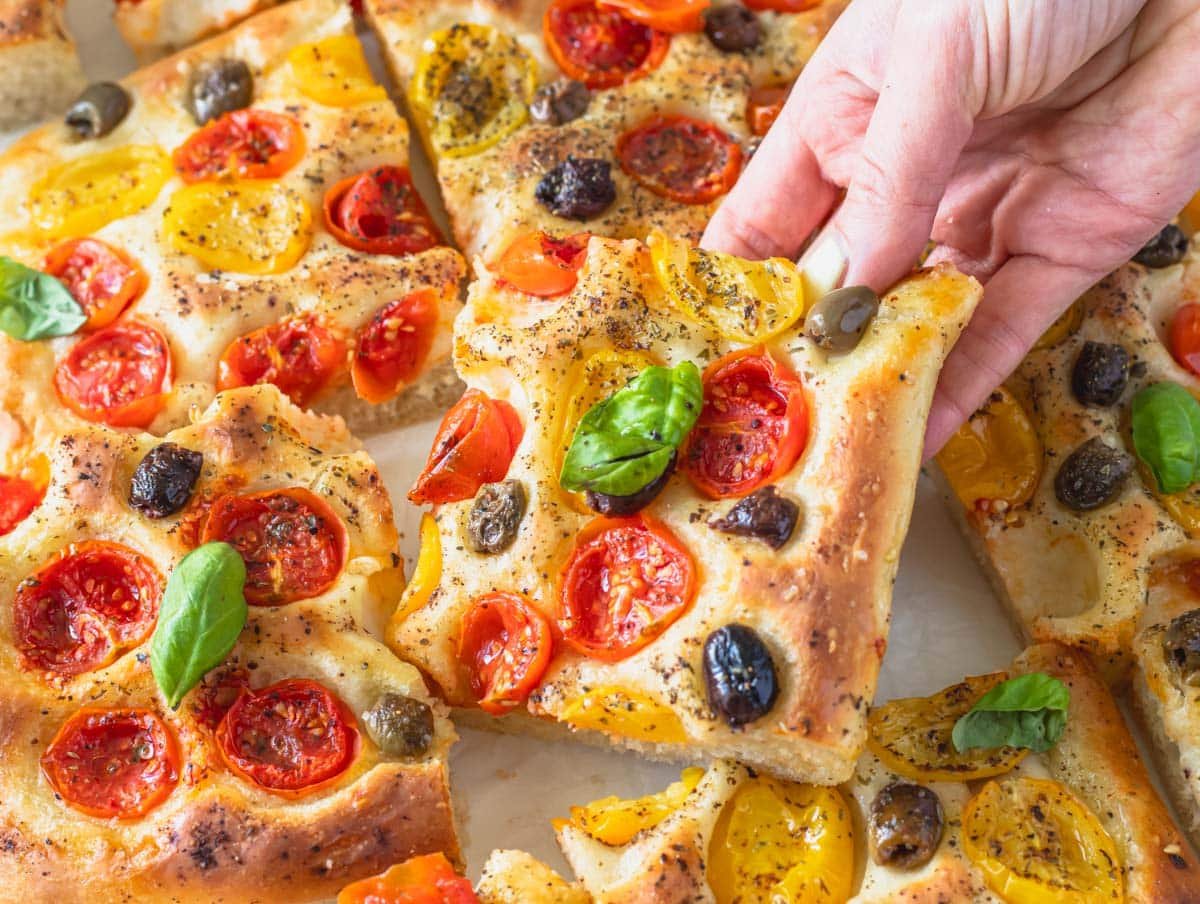
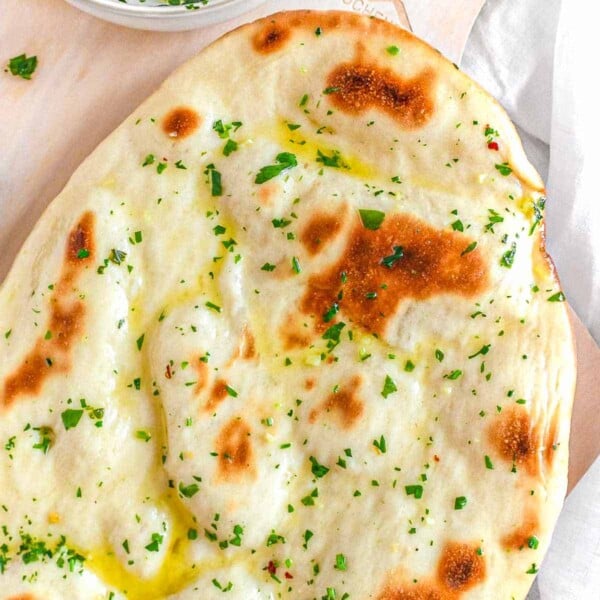
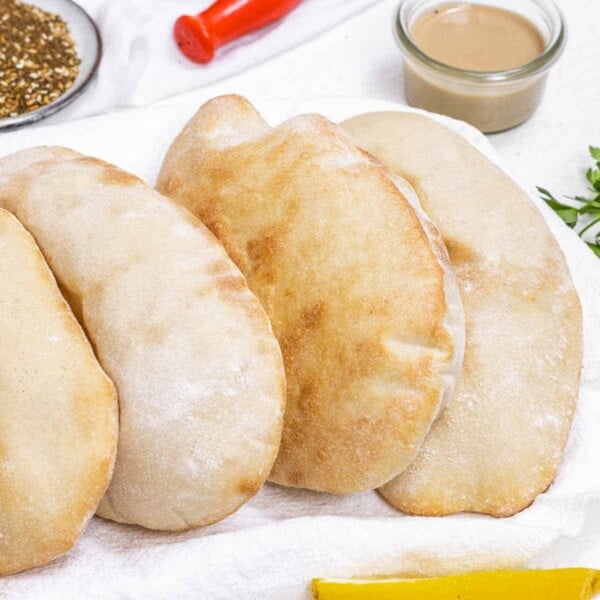
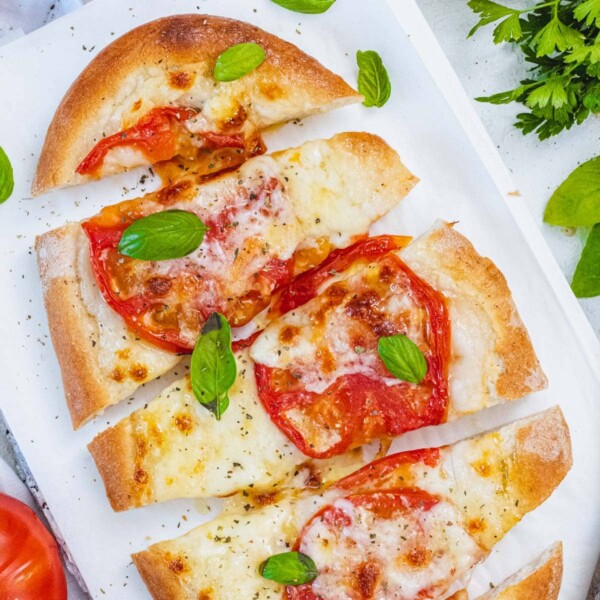
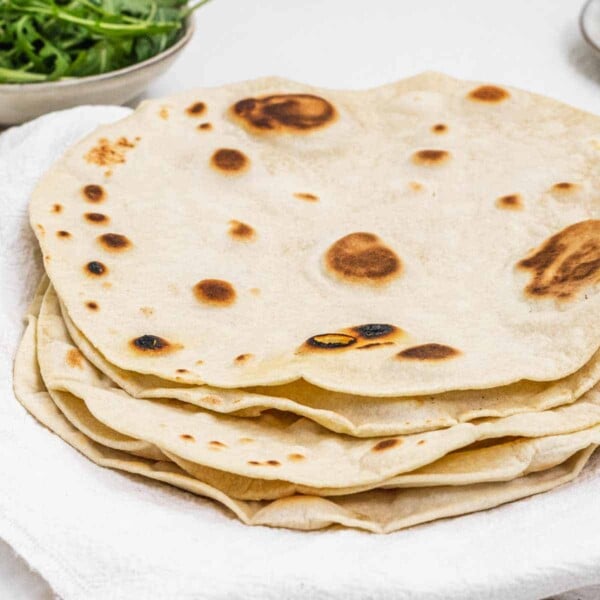
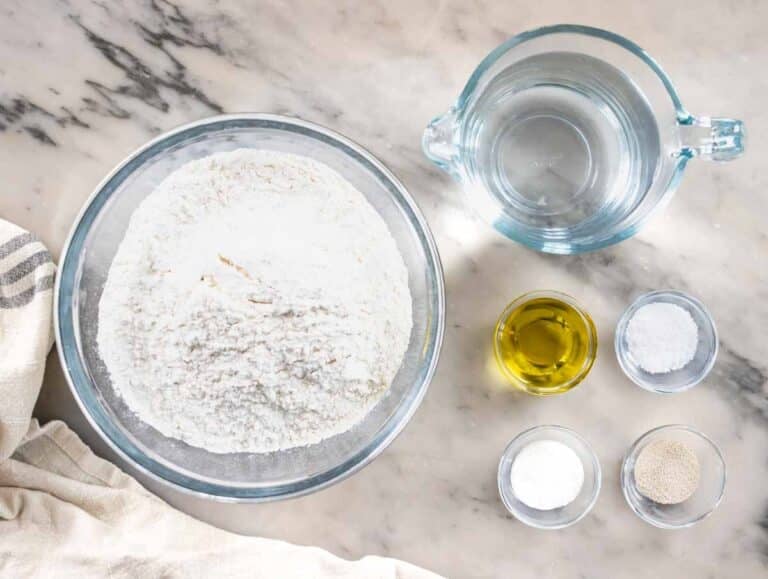
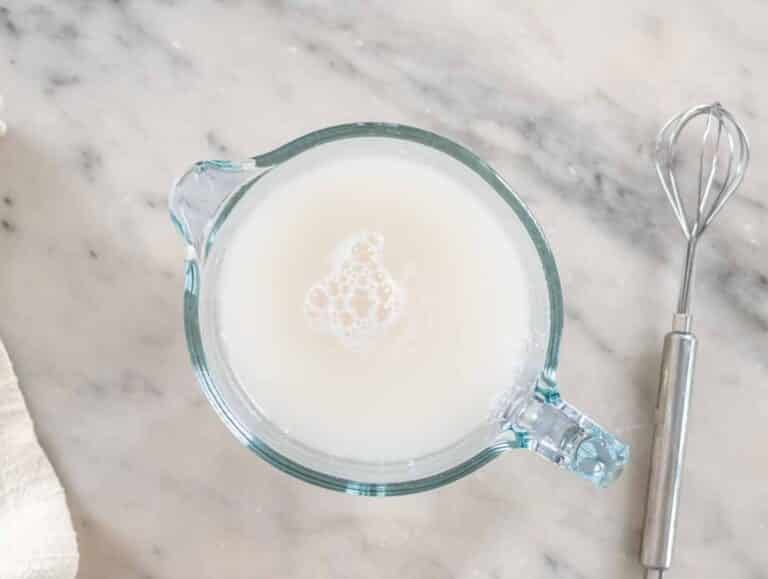
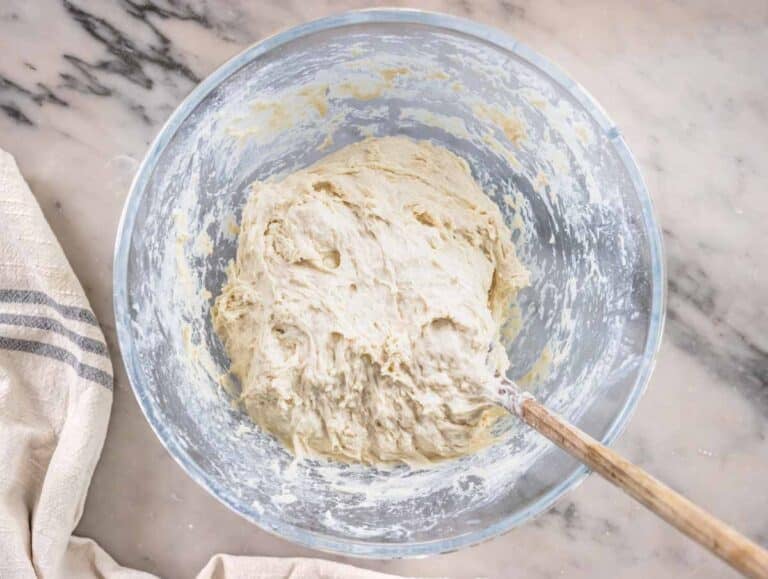
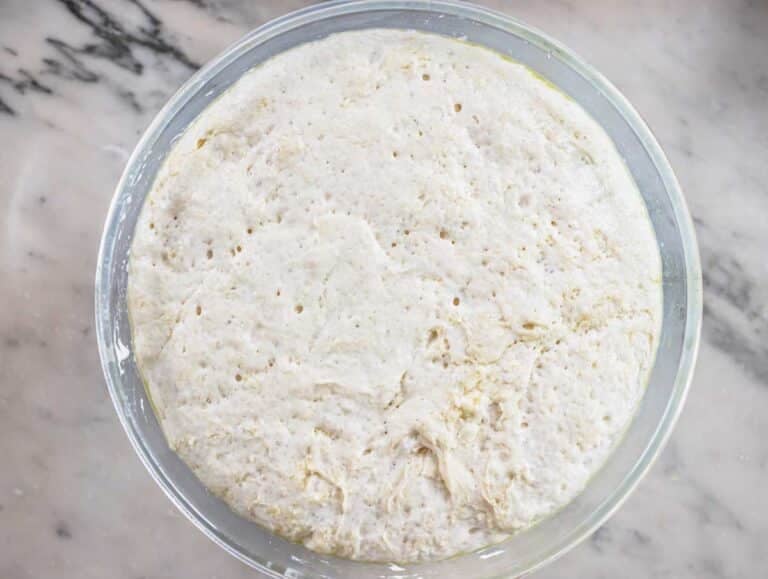
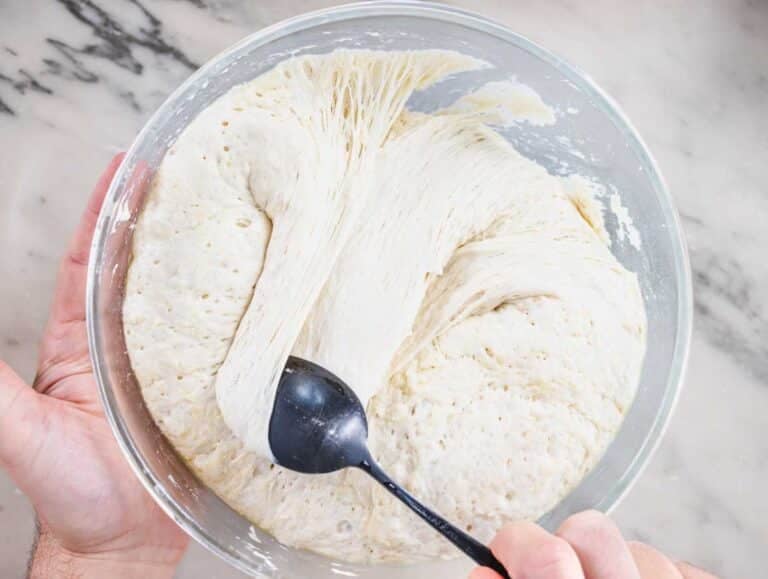
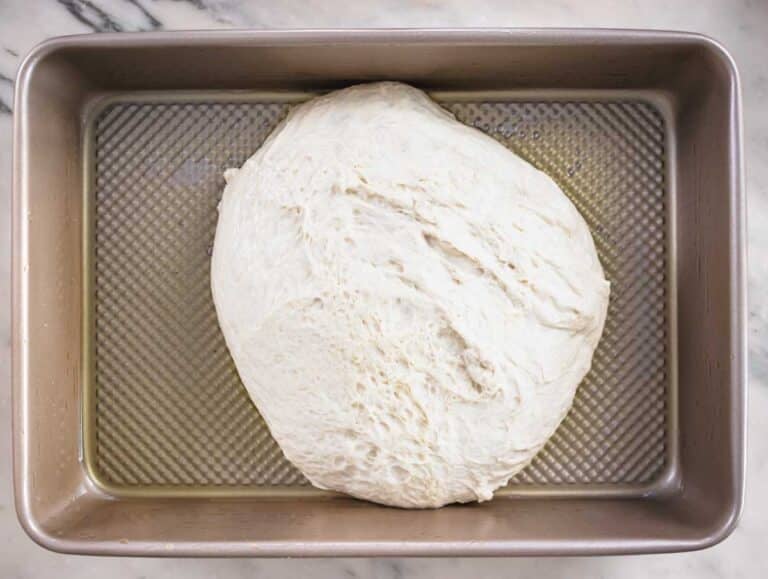
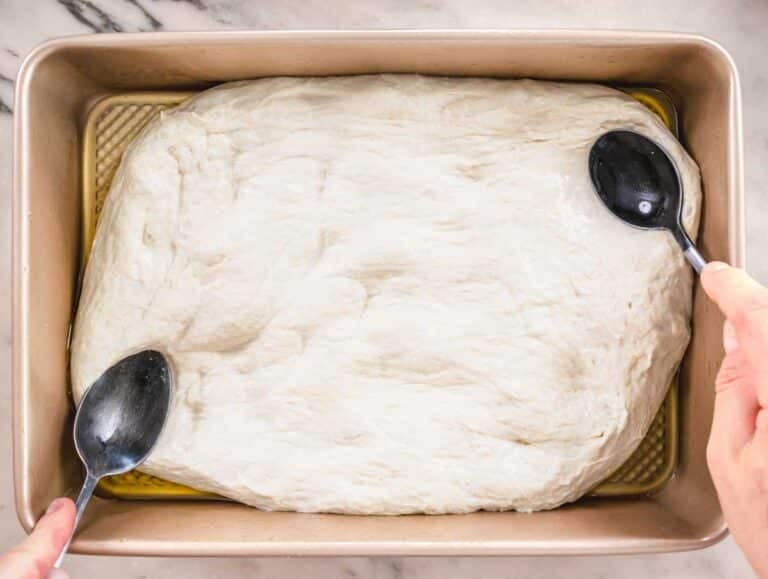
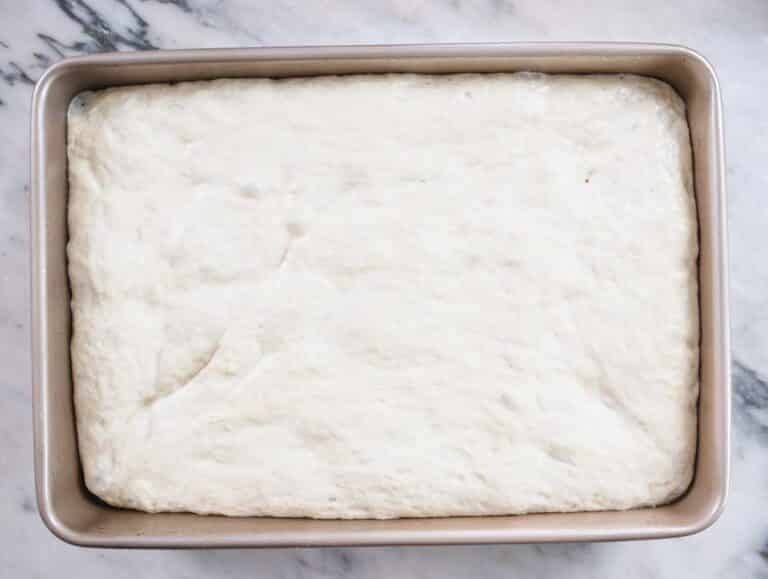
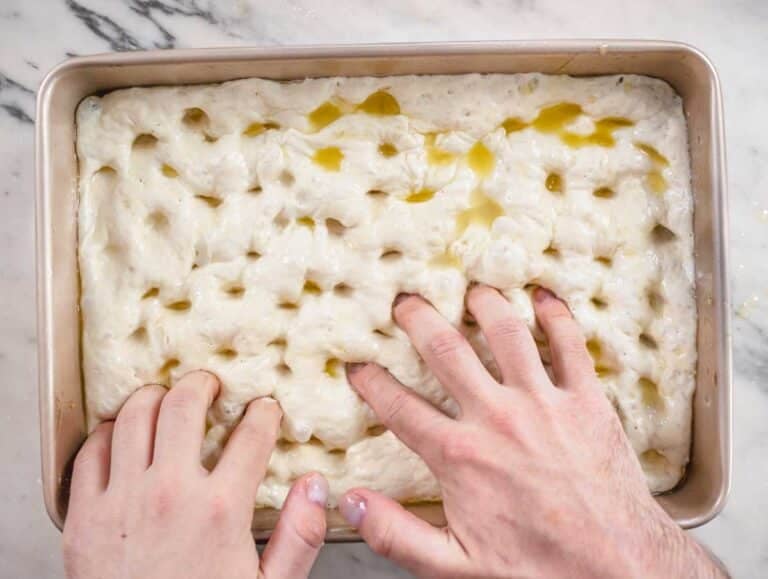
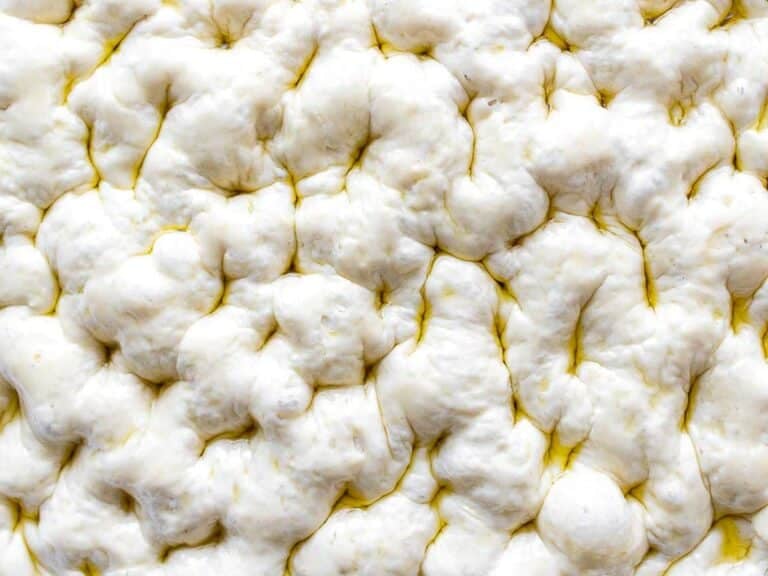
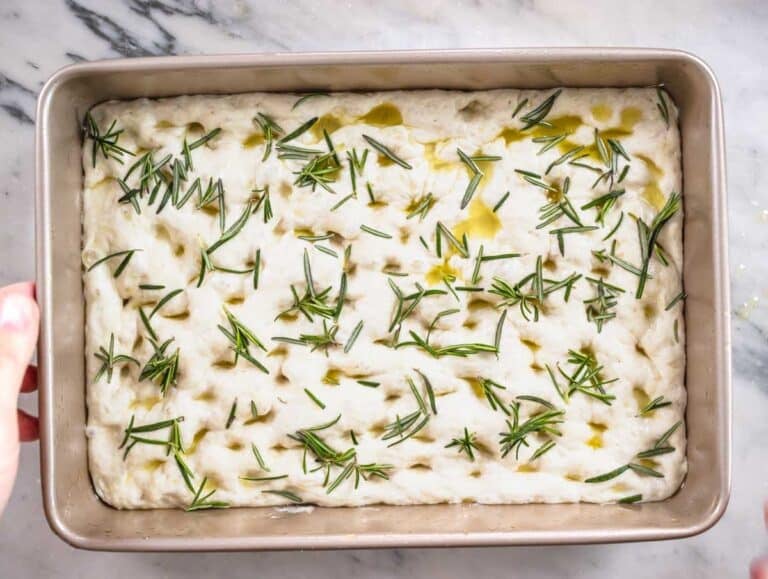
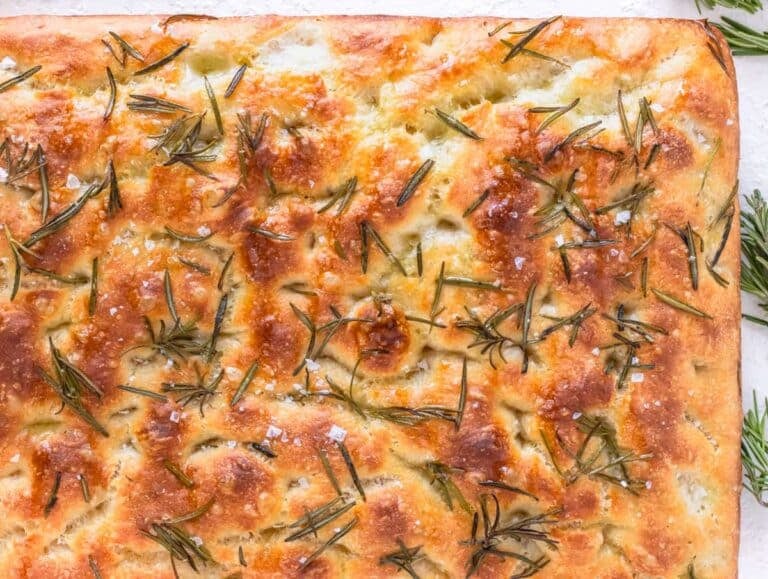
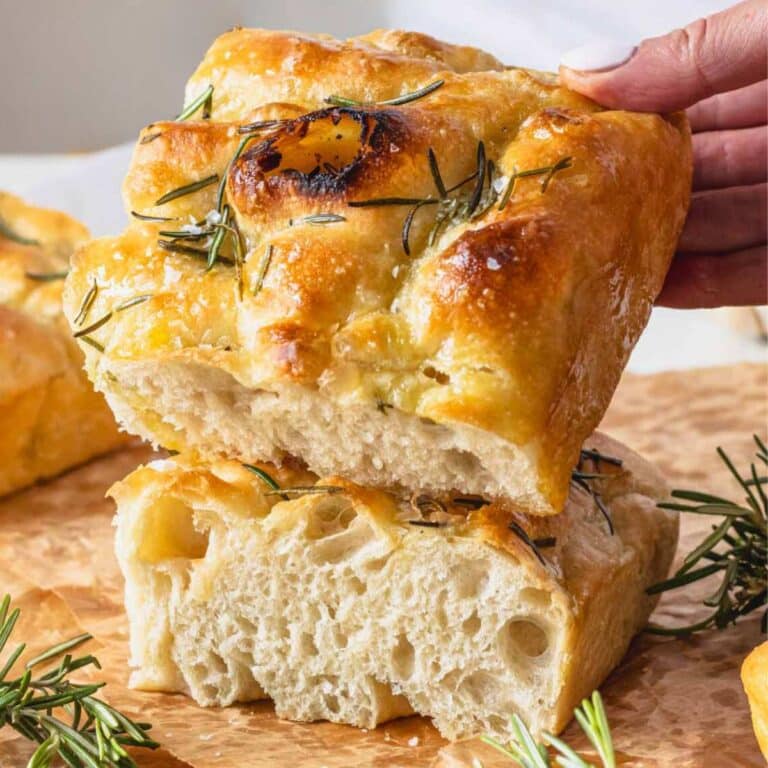
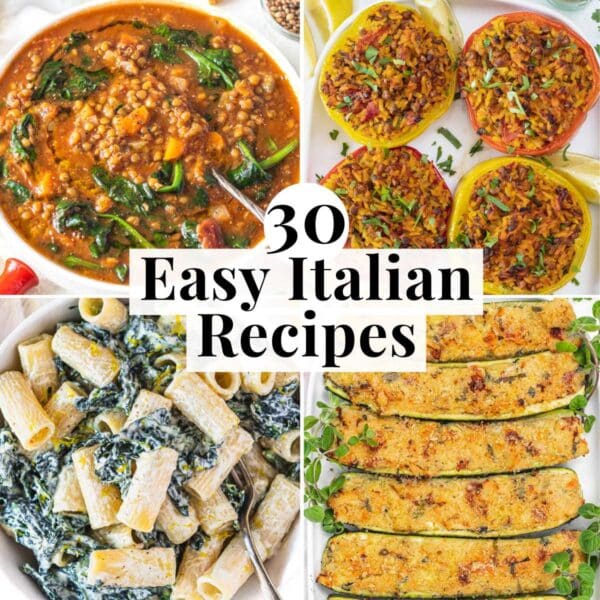
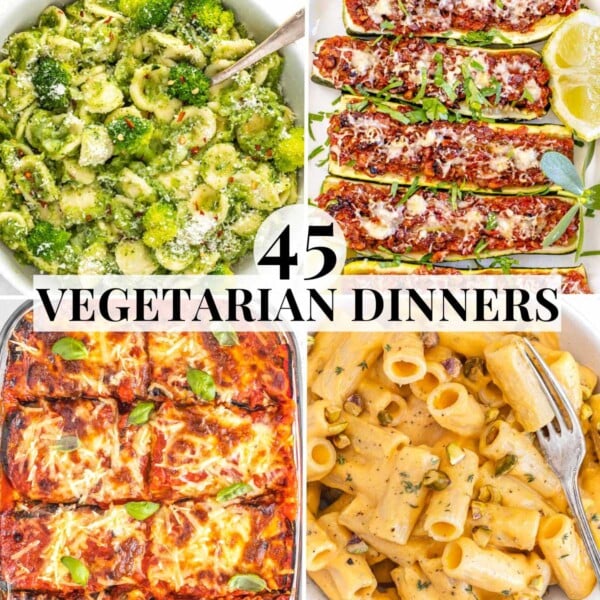
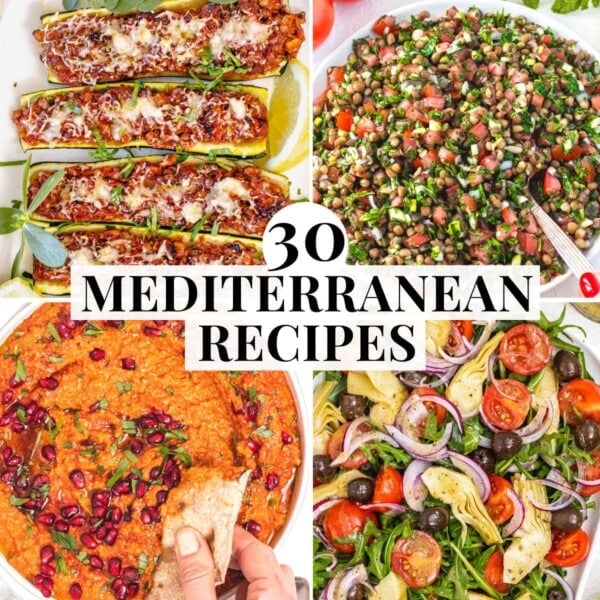


Unfortunately I found this recipe to not work out at all without changing it. The amount of salt made it completely inedible. I had to drastically reduce it. I needed more water- over 2 cups- to get the texture right so it would pull together and look like it does in his video. It’s possible this all has to do with different measuring amounts/volumes on American vs European cookware. I just noticed the button to click to switch the volumes to metric; I’m making it again today so may compare the measurements hands-on. I had success with the recipe after a few tries of modifying it in the ways mentioned above.
Do you use glass bowls for proofing? Can you use metal like stainless steal? Cook in what kind of pan? Can you use an air fryer?
I Sue,
thanks for your message.
You can use any bowl for proofing; glass, metal, wood, and china bowls.
For the pans, I use either a stainless steel pan with non-stick coating (that’s the one in the pictures) or Nordicware aluminum pans – you’ll need quite a bit of oil for these, or parchment paper to prevent the focaccia from sticking.
Yes, you can use an air-fryer, but if your air fryer has it, use the BAKING function. Cooking time might vary so check the focaccia more often.
I hope this helps 🙂
Wish you a wonderful day.
Nico
Hi Nico,
Thank you for this focaccia recipe!! I have made it a good few times now and it’s a hit.
I have a question about the metric flour ratio. I usually calculate 1 cup to 120g of flour so I have been using 480g not 600g. I haven’t tried the recipe at 600g but would you recommend that I stick with 480g or add another 120g? The dough does seem more wet and sticky than in your photos, but it still cooks well and tastes delicious!
Thank you!!
Hi Tash,
Thanks for your question. I am happy you like the focaccia 🙂
For flour, we calculate 1 cup = 150 grams, so I would recommend adding that extra 120 grams.
I hope this helps 🙂
Nico
Omg amazing . Followed the recipe to the T . Did the overnight proofing . Always had a hard time with bread making , but this was easy and tasty
I was wondering if after the first proof then I fold the first time, can I put it in the fridge to proof overnight due to schedule conflict?
Hi Zoila,
Usually the dough should proof in the fridge before the first proof. I’m afraid, I haven’t tried putting it in the fridge after the folding. Not sure how it would turn out.
I love this recipe. Easy to make. I proofed it overnight and it worked out great!
Fantastic, G.Z.! I’m delighted to hear 🎉